Japanese Art History Midterm #2 Review
1/72
There's no tags or description
Looks like no tags are added yet.
Name | Mastery | Learn | Test | Matching | Spaced |
|---|
No study sessions yet.
73 Terms
Tai-an Tea Room, Myōki-an, Kyoto, 16th century
Sen no Rokyu’s tea room in a hut
The most distinguished tea-master of the wealthy Sakai merchant class
Promoted spiritual ideas of ‘harmony, represect, purity, and tranquility’
Noted for having taken the eat ceremony to its farthest extreme
Asymmetric and irregular forms
Rough textured earth walls, unpolished exposed beams
Small in size
The tea house as a personal art forms, catering to the intense Japanese need for the preservation of the private self as distinct from the public space
Shoin-style architecture
Teahouse
The small space forces intimacy and participation
The tea ceremony is very slow and silent
big emphasis on slowness and silence during the whole process
You still have to show your appreciation despite not speaking since everything was made specially and carefully for you
wabicha 侘茶—first formulated by Murata Shukō 村田珠光 (or Jukō, 1423-1502)
“Tea based on wabi”
Sen no Rikyu achieved the ultimate wachiba settings by adopting as his preferred teahouse a stark hut of only two mats in size, which could at most accommodate two or three people in one gathering
There was a compatibility between formal tea, using such utensils, and the “grass” style of informal tea without them
Rikyu found wabi in the vernal grasses amid the snow from late winter to early spring
Shoin-style archtiecture
Chigaidana: asymmetrical overhanging shelves
Fusuma: traditional sliding doors
Shoji: the newer, lighter sliding doors
Consisted of lattice like wooden frameworks with translucent rice paper pasted on one side
Tatami: standardized rush matting used to cover floors entirely
Tokonoma: an alcove
Longquan-ware (celadon) water joa, Song dynasty, China, ca. 1200
Tenmoku (Jian ware) tea bowl, Song dynasty, China, ca. 1200
Korean tea bowl, 15th-century Joseon Korea
Black Raku tea bowl named “Katsujishi” by Chojiro, Momoyama period (16th century)
Weathered over time, wabi aesthetic in the imperfections
Oguro was made during a period of war, thus more dark and simple
More evocative because it makes the viewer more imaginative
More austere ->closer to samurai values of the tea ceremony
Shino-ware (志野焼) tea bowl known as “Kogan” (“Ancient Shore”)
in the wabi-sabi spirit
Cracked and weathered, rustic
Spring grass in the snow?
Nature aspect
Shigaraki-ware (信楽焼) water jar, 15th century
`Rustic flare -> tied to Shinto with the nature aspect
Iga-ware (伊賀焼) water jar known as “Yabure-Bukuro” (“Torn Pouch”)
Himeji (White Heron) Castle, first built in 1346, rebuilt by Hideyoshi in 1581
The purpose of castles is defense, fortification, and also for living quarters and an office for administration purposes
Surrounded by a moat to pose as an obstacle for enemies (first layer of defense)
First gate (second layer of defense)
Second gate
Irregularity in the placement of gates to make enemies lost (should they find their way in)
Third, fourth, fifth gates
The tower (main structure)
Timber structure surrounded by stone
Limited natural light for the sake of fortification
Ōhiroma (Great Audience Hall) of Ninomaru Palace, Noji Castle, Decorated with Kanō Tanyū’s painting of Pines, 17th Century, Kano School
First built by Tokugawa Ieyasu in 1602 with two main structures
Ninomaru Palace with Ohiroma (Great Audience Hall) in the center
Shoin-style architecture on a larger scale compared to tea houses
Separate rooms designated for specific groups of people -> elevation is used to determine hierarchy/rank
Ex: samurai/bodyguards/attendants, general public, close friends/allies, the shogun
A sense of vulnerability and gentleness
Sliding doors
Ohiroma (great Audience Hall) of Ninomaru Palace, Nijo Castle, with Kano Tanyu’s paintings of Pines
The gold background helped to reflect the little natural light and candlelight in the dark rooms
The gold was also considered expensive and tied to power
Eitoku, Cypress, Kano School, eight-panel byōbu (folded screen), Momoyama period, ca. 1580
Twisting, gnarled cypress trees set against a background of rocks, azure water, and gold-leaf clouds
Very bold
Old pine and evergreen trees shows hardship since they’re able to survive so many winters
Shows power and vigor and endurance
A big pine tree was always used as the main subject of panels (so big that parts have to be cut off)
Cut-off composition continues from Tale of Genji paintings
Gold clouds
The choice of the specific tree (Japanese cypress) is tied to the Japanese identity
Byobu was mainly used during the Heian period
It means portable
Eitoku’s is much bolder, with less attention to detail (compared to Tohaku’s Maple tree and Flowers)
More bold and masculine
More defined
No signature
Bold in color
Lots of details
more decorative
Strong sense of a pattern
Echoes of the shape of the branches in the background
Eitoku, Kano School, Four Season Landscape, 16 fusuma (sliding-door) panels, Momoyama period, 1566
Kano school style is rooted in Chinese landscape paintings
It was this that the personal style of Eitoku emerged against the more conservative one of Shoei, most notably in his monumental forms of the pine tree
The form of the sturdy pine trunks dominates the composition, bringing the foreground elements closer to the picture plane and the viewer
At the same time facilitating the rapid horizontal, sequential movement of the panels from right to left
He always emphasized the picture plane and made no effort to draw the viewer’s attention into the background
He was preoccupied with the rendition of a single motif dominating a composition
Kano school style: singular, dominant motif that occupies the focus and extends beyond each panel
Reminiscent of Yamato-e with the small subtleties and the sensitivity to nature and the changing of the seasons
Very evocative
Very sketchy (brushstrokes are very obvious)
Eitoku, Kano School, Four Season Landscape: Spring, 16 fusuma (sliding-door) panels, Momoyama period, 1566
Very sketchy and calligraphic (the hand/brushwork of the artist is very clear)
Not a gold background, but yellowish
Eitoku, Kano School, Four Season Landscape: Autumn, 16 fusuma (sliding-door) panels, Momoyama period, 1566
Very chinese
Very poetic
Eitoku, Kano School, Four Season Landscape: Winter, 16 fusuma (sliding-door) panels, Momoyama period, 1566
Tohaku, Maple Tree and Flowers, four fusuma panels, color and gold leaf on paper, Momoyama period, 1592
Kano school style/composition
He trained in the Kano style
Made right after Eitoku’s death
Importance and prominence of Eitoku
Tohaku’s is much more dynamic and detailed (compared to Eitoku;s Cypress)
Also has a stronger diagonal in the angularity of the tree
Much more subtle -> attention to details
Particularly the details in the leaves and flowers of the tree
Very sweet, more feminine
More reflective of the taste of the urban townspeople
Tohaku, Pine Trees in Mist , Right screen; pair of 6-panel screens, ink on paper, late 16th century
Completely opposite of the Kano school style
Far more simple
Ink monochrome
Only black and white
Reminiscent of Zen paintings and Sesshu’s work
Asymmetry, simplicity, unadorned loftiness, spontaneity, spiritual depth, unworldliness, inner serenity
Sense of eeriness and mystique
Lot’s of space, very atmospheric
Subtle and faint lines for the mountains in the background
Lack of a center -> no dominant motif
There is still a motif of the pine tree but executed differently
repetition through variation
A sense of rhythm, lot’s of vertical and diagonal lines
A diagonal leads the viewer’s eyes to the mountain
A superb synthesis of chinese media and techniques with japanese expression
Nearly 85% of the painting surface is left blank and yet the entire screen is suffused with a sense of the mists and stillness of an autumn dawn
He shows the trees tall and gaunt, using a straw brush on thin, coarse paper, varying the intensity of his ink from faint to dark in swift, sure strokes
His cluster of pine trees strikingly enhance, in the best Zen-like tradition, the emptiness of the remainder of the screens’ surface
This painting is the culmination of his attempt to unite the Chinese and Japanese artistic styles
The grove of pine trees, which had long been a favorite subject of traditional yamato-e paintings, has here been executed in the new Chinese style of ink painting
The deception even permits the flickering of the morning light in the mist to be perceived, and most importantly, the sense of progress in time from dawn to the early morning, suggested by the movement of mist through the pine trees
This insertion of the time element in a painting is clearly the expression of the concept of mujo which symbolizes the ever-changing nature of worldly phenomena, and is the essence of Japanese art
Kōetsu, Raku tea bowl named “Fujisan” (Mt. Fuji), early 17th century, Rinpa School
The opaque white glaze over the upper half, leaving the darker glaze for the bottom creates an effect by firing of gently falling snow
The vigor and grandeur of Mount Fuji are suggested
The impression is of monumentality
Keotsu echoed the simplicity and purity of Rikyu’s time, following the forthright form produced by Chijiro
Shows the rise in the tea ceremony
Rinpa school style
Compared to Black Raku tea bowl named “Oguro” by Chojiro, 16th century
Fujisan is more of a literary reference
White is used to represent snow (snow-capped mountain top)
A bit more of a sense of flavor
Shows the more urban tastes of merchants/consumers
a sense of rustic beauty
Kōetsu, Inkstone box "Boat Bridge,” Momoyama-early Edo, early 17th century, Rinpa School
Contains inkstone, ink, and brush
Clearly inspired by Heian lacquers
Although the box is nearly square, the decoration is entirely asymmetrical
Balance is restored by the inscription of a waka poem, applied in high relief silver over the whole scene
Rinpa school objects all had names
Merchants emphasized good taste since they were of the lowest class
They wanted to show their money
Everything expensive: lacquer, gold, silver, etc
Also wanted to show their education
Reference to poetry
SŌTATSU, Waves at Matsushima (Pine Island) pair of 6-panel screens, ink, color, gold and silver on paper, Rinpa School, early 17th century
Decorative style of the Rinpa school
Makes reference to Ise Shrine
Blue and green are reminiscent of the Heian period and yamato-e
The pattern of the lines in the waves is reminiscent of the Asuka period and its decorative patterns
Sotatsu and Toshichiro, Painted Fans Mounted on a Screen, pair of 8-panel screens, ink, colors, and gold on paper, early 17th century, Rinpa School
Decorative style of the Rinpa school
The fans show images that were popular during the Heian period
The clothing of figures, yamato-e landscape
Fans with rich references -> like tale of genji or a war from the past
Creates something very narrative in the storytelling of the fan images
Kōetsu and Sōtatsu, Flowers (silver pigment) and Grasses (gold pigment) of the Four Seasons, section of a handscroll in the tarashikomi (dripped in) technique, Rinpa School, early 17th century
Rinpa style: repetition of the same motif: flowers
Sensitivity to nature/preference for the four seasons leftover from the Heian period
Gold and silver pigments for color
Koetsu’s calligraphy is heavy and dark, but there are also thin lines
Lots of movement, doesn’t follow a specific structure
Tries to fit in with the composition
Ex: diagonal instead of vertical
Kōetsu (calligraphy) and Sōtatsu (painting) Deer Scroll, sections of a handscroll, ink and color on paper, 1615, Rinpa School
Rinpa style
Repetition of the same motif: deer
A cut-off figure
Heian style calligraphy: cursive, quick and rushed brushwork, the characters blend and flow together
Mix of thick and thin, dark and light lines
Very elegant

Korin, Irises at Yatsubashi (Eight Bridges), pair of 6-panel screens, ca. 1710
Best known painting, in a purely design-like and decorative manner
Inspired by an episode from The Tales of Ise
Made no attempt to reproduce the narrative itself, but simply placed irises in “disembodied” fashion against a stark gold-leaf background
The flowers seem almost to dance before the viewer’s eyes due to the stark contrast of blue and green against the golden screen
The screens seem flashy and light
Traces of black ink outlines are visible here and there
The flower petals have slight shading
The white base color is apparent
All of these elements create a sprightly and showy effect
The gold is shiny and bright
The irises are more realistic, their shape suggesting a variety known as iris laevigata
The bridge is quite stylized
Painted in 1711 to 1715, after Korin returned to Kyoto following a disappointing move to Edo (Tokyo) in search of new patrons
Reflects when the daimyo in Edo had a more conspicuous celebration of classic themes
The later one is a bit more shiny and bright
The gold is heavier
Also has a black outline
Two-step process -> more time consuming, thus more labor needed, thus likely more expensive
Appealed to the taste of the merchants
The bridge and irises come from the story of the Tale of Ise
A literary/narrative reference
A way for the merchants/patrons to display their education along with their wealth
Also a reference to the Heian period through this literary reference

Korin, Irises, pair of 6-panel screens, ca. 1701
Repetitions of a single motif: blue irises, green leaves
Motion is created in the asymmetrical grouping and the repetition of the motif out-of-phase
His daring and unrelenting use of gold, blue, and green, where Korin displays his supreme self-confidence
By removing all external props, “framework” or “borders,” both men plunge the viewer into the scene, and create a sense of dramatic immediacy and personal involvement
The screens seem formal and still
The pigments are built up
In places where the leaves overlap, the individual blades are indicated by the layering of pigment, without the use of outlines
The gold luster is subdued and slightly brown in tone
The irises are fuller and larger, their shape resembling the species known as iris ensata
Painted around 1701-1702, when Korin received the honorary title “bridge of the law, or dharma”
Reflects the popularity of gorgeous gold screens in Kyoto among both court nobility and wealthy townsfolk
the earlier one’s pigment was applied through layering
tarashikomi (dripped in) technique: the method of dropping ink or color pigment on to still-wet areas of the painting surface

Pair of 6-panel namban byōbu by an anonymous Kanō painter color and gold leaf on paper, 17th century
One showing the departure of the Portuguese carrack (great ship) from Goa or Macao and the other its arrival at Nagasaki
More tied to the imperial court
Depicts both Western and Japanese figures
All figures have a ¾ view, looking at the painting of Jesus, except for two figures
One figure is looking directly at the viewer to engage the viewer
Another figure is fully turning their back away from the viewer and facing the Jesus painting
Makes the use of space more interesting
Creates a communication between the viewer and the painting
Jesus looks like Confucius
Nanban (or Namban) 南蛮—literally “Southern Barbarians”
The foreign and exotic culture of the Portuguese traders and Jesuit missionaries
Much of namban art was either iconographic or religious, but some depicted European cities, landscapes, and nonclerical people
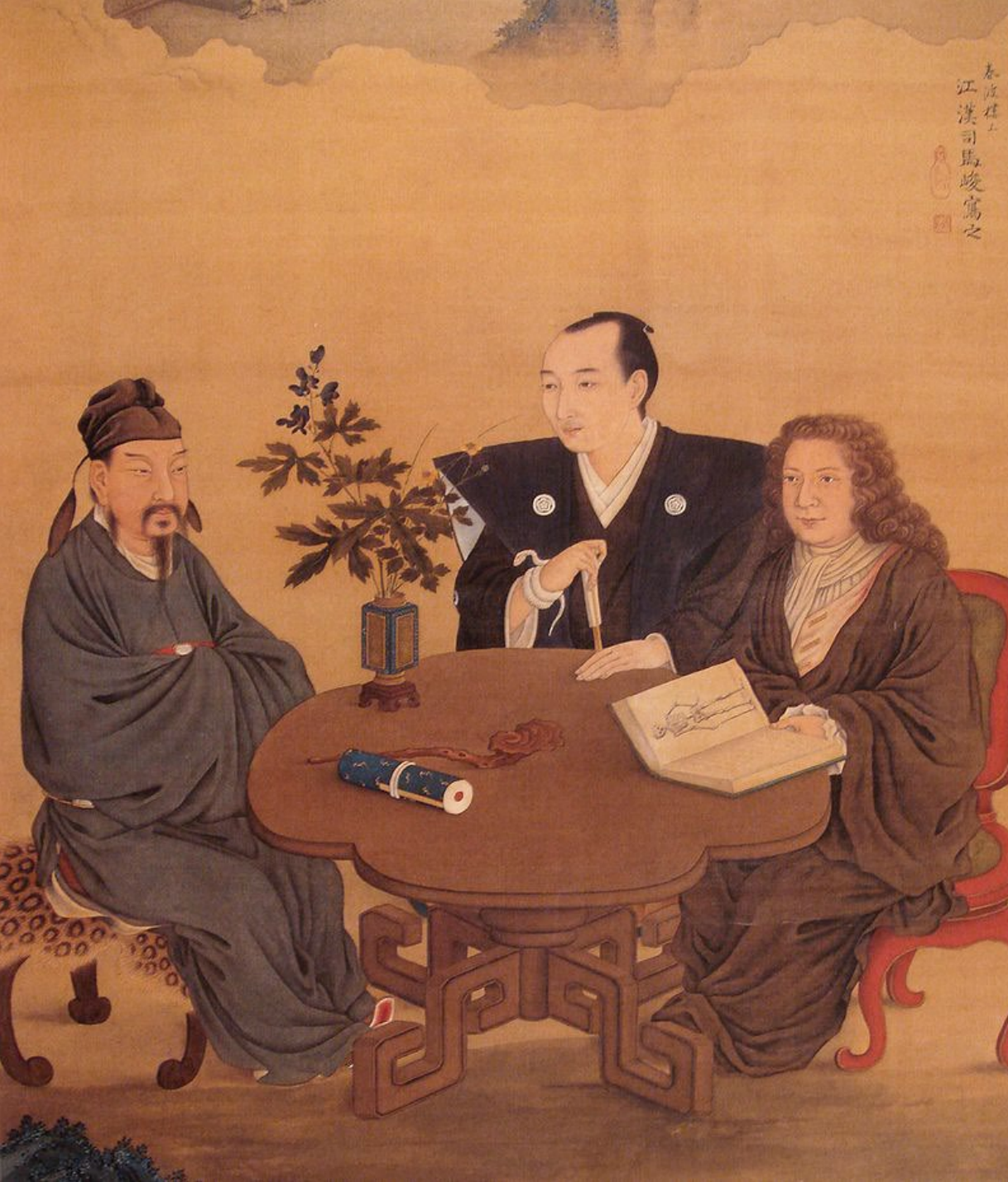
Shiba Kōkan, A meeting of Japan, China, and the West Late 18th century
Separation between China and the West + China by a decorative vase
The Dutch and the Japanese figures are placed sitting close together
An alignment of Japanese with the Dutch
Japan is moving further away from China’s influence and closer to the Netherlands’ influence
China is depicted as something old and ancient
The Dutch depicted as new and modern
Dutch figure: western-style chair
holding a medical book (?) with a picture of a skeleton
Chinese figure:
has a leopard print chair, Chinese-style furniture
has a wooden object in the shape of a fungus
a Chinese-style handscroll
Japanese figure in the middle
represented by the geometric Japanese style of furniture
Holding a folded fan
A snake wrapped around his wrist
Tied to Shinto and Japanese sensitivity to nature
Old-fashioned vase and maple leaves
None of the figures are looking at the viewer
Kano School style
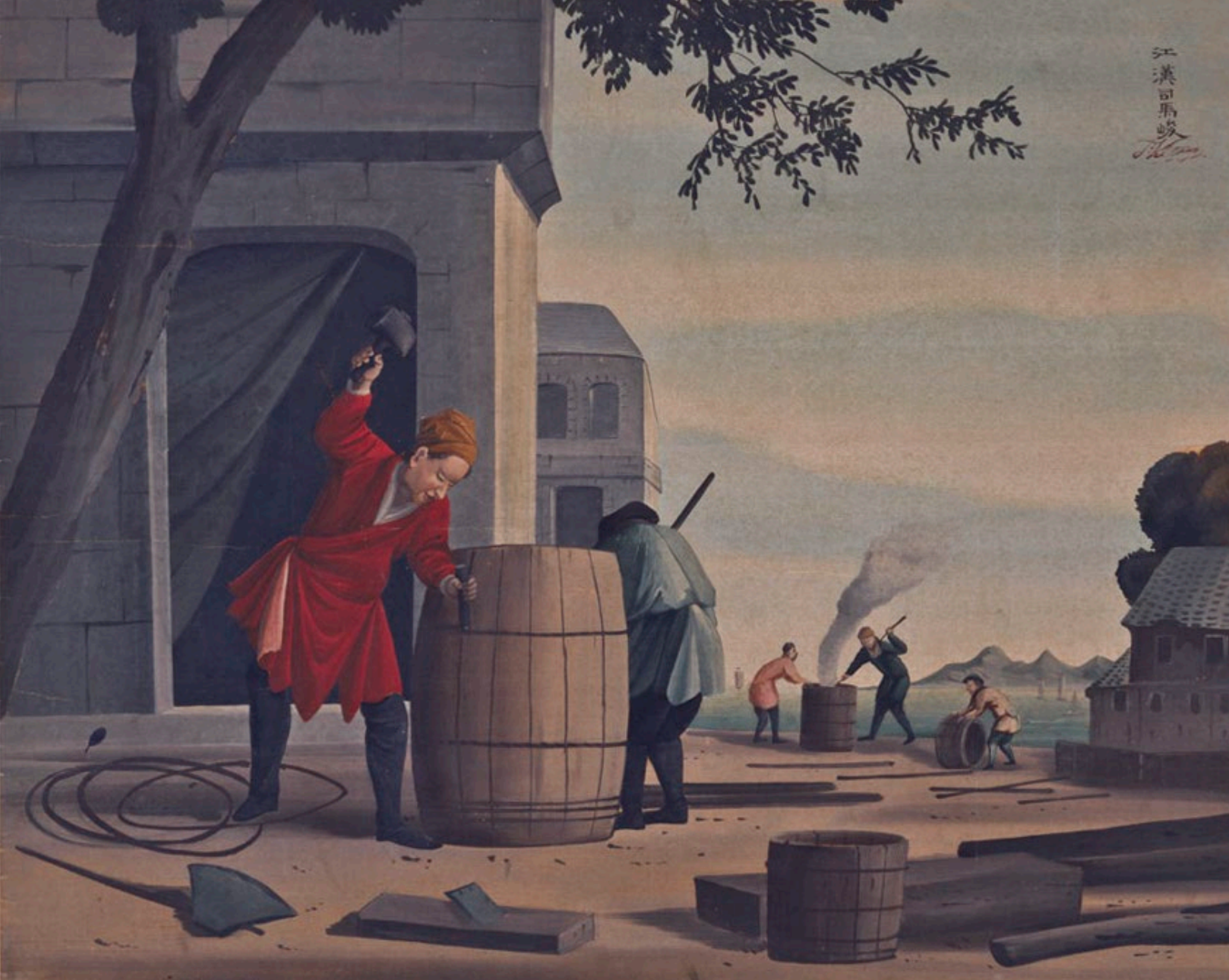
Kōkan, The Barrel-maker, ca. 1789, hanging scroll, oil on silk (yoga)
“-ga” associated with foreignness/non-native things
Based on/inspired by an imported print
More alignment of the Japanese with the Dutch
Done using western-style of painting and technique (oil)
The figures are also in western clothing
The tree framing the painting adds a touch of Japanese style
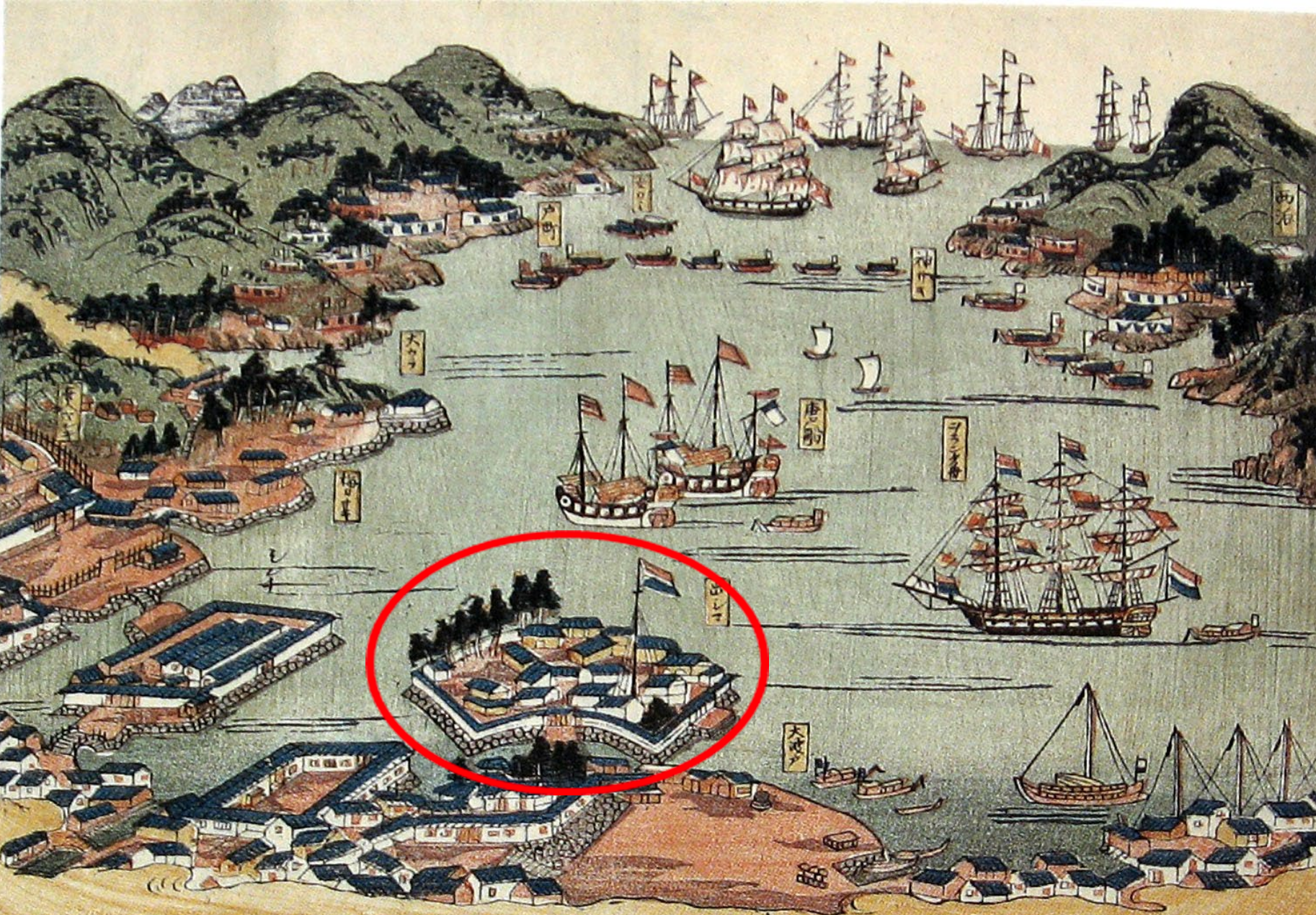
Anonymous, Bird’s-eye View of the Port of Nagasaki with the fan-shaped Deshima in the foreground, c. 1854-64, Oban woodblock print
Dejima (or Deshima) 出島 in Nagasaki Harbor, built in 1634 (through 1854)
An artificial island was created for the Dutch at the Port of Nagasaki called Deshima
The Dutch were the only Westerners allowed, so the Japanese could learn from them
The island allowed the Japanese to still closely control the Dutch

Maruyama OKYO, Sketchbook of Insects: Cicadas and Bees, ca. 1750
An observation of life
The same subjects in different perspectives
Western training
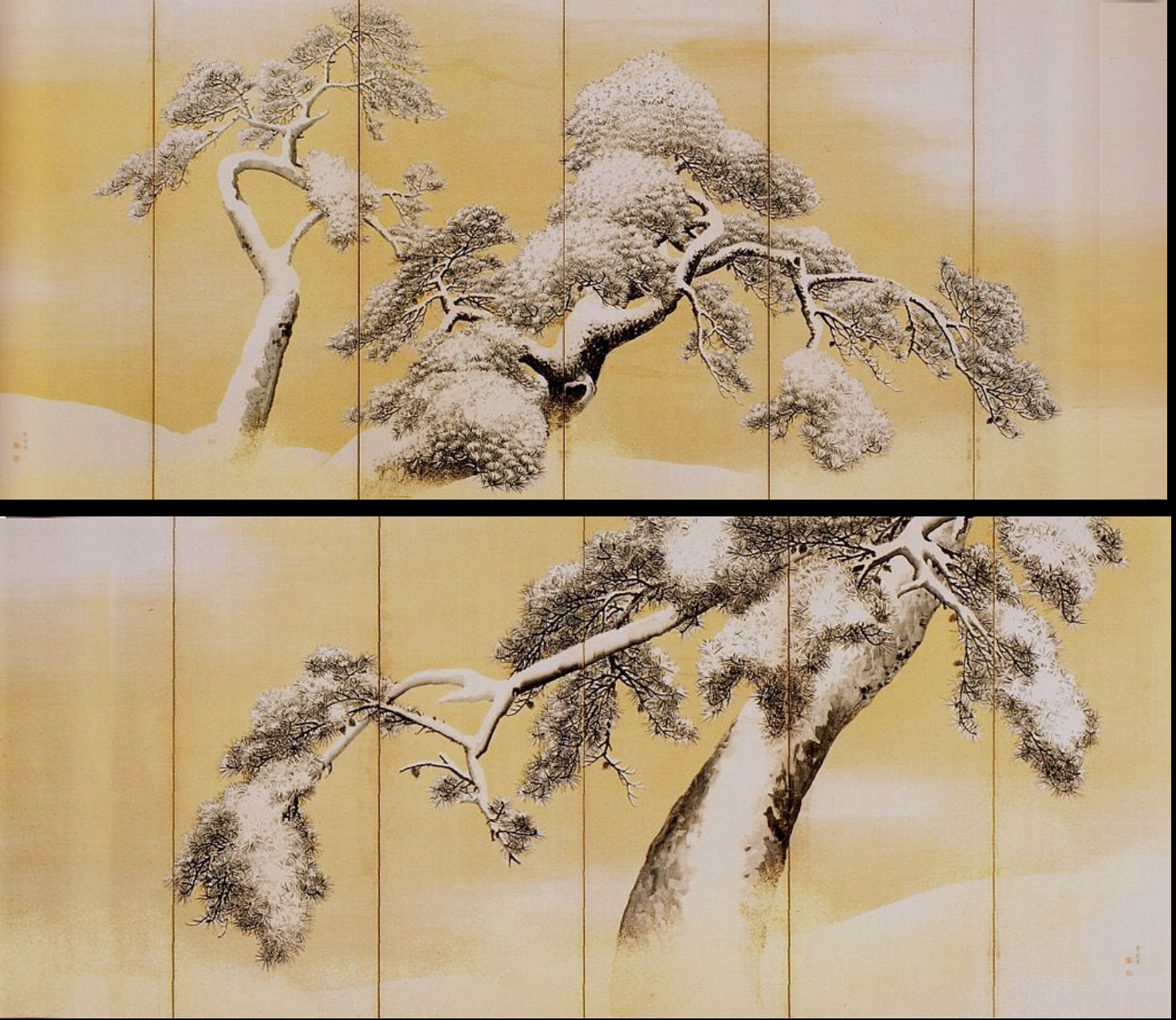
Maruyama ŌKYO, Pine Trees in Snow in the tsuketate technique, pair of 6-panel byōbu, Edo period, ca. 1780
Compared to Eitoku’s Cypress, ca. 1580
Okyo’s Pine Trees
Less bold in color
Same singular motif of a tree
The tree is cut off due to its size, just like Eitoku’s
Has a signature at the bottom
Both have stretched out branches
More simple
There’s a certain kind of air circulating
A modern feeling through the simplicity
Same subject of a pine tree
Also an observation from life
Molding and shadows to create texture and volume in the tree trunk
Through the use of the tsuketate technique
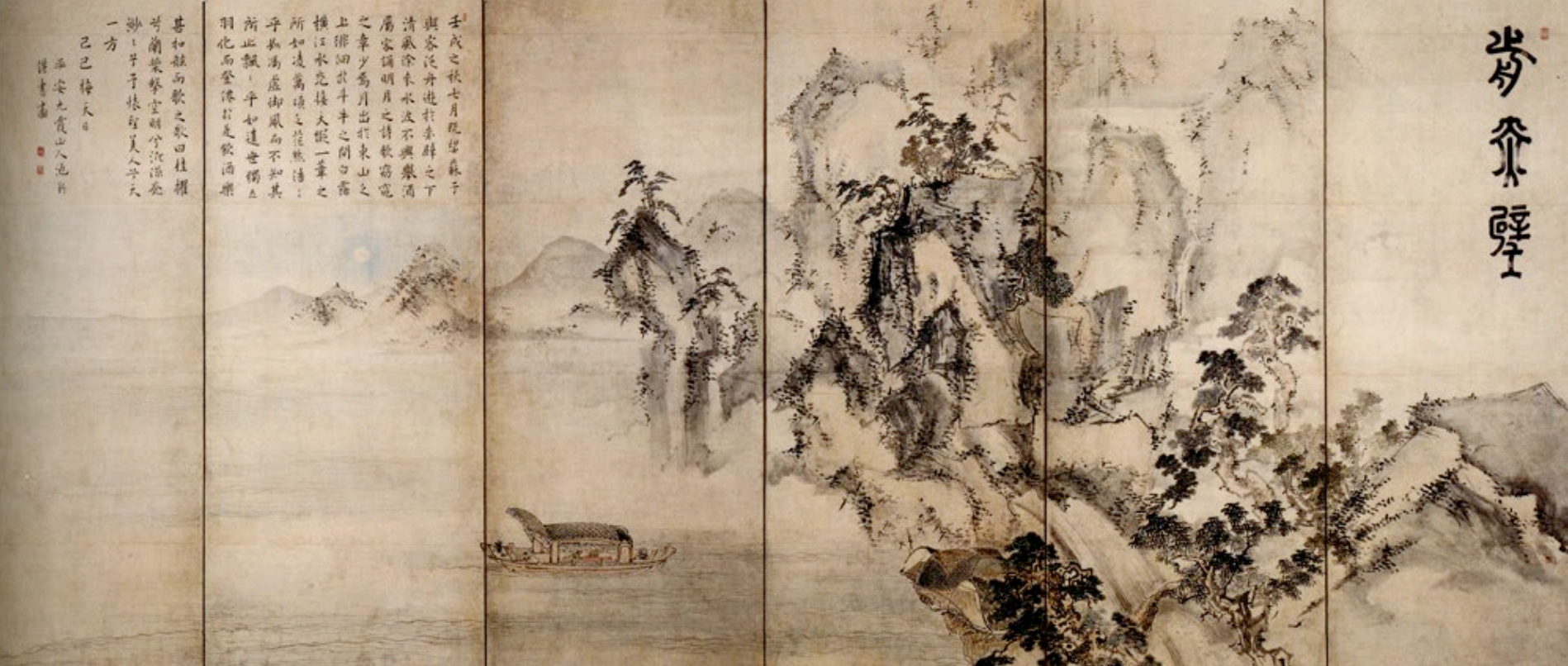
Taiga, First Visit to Red Cliff (illustrating a poem by Chinese poet Su Dongpo in 1082), one of the pair of six-panel byōbu, Edo period, 1749
A historical location where a famous battle took place (a literary reference)
Archaic style of calligraphy for the title
Like a typical Chinese-style painting
It’s still Japanese in the 6-panel byobu format
nanga
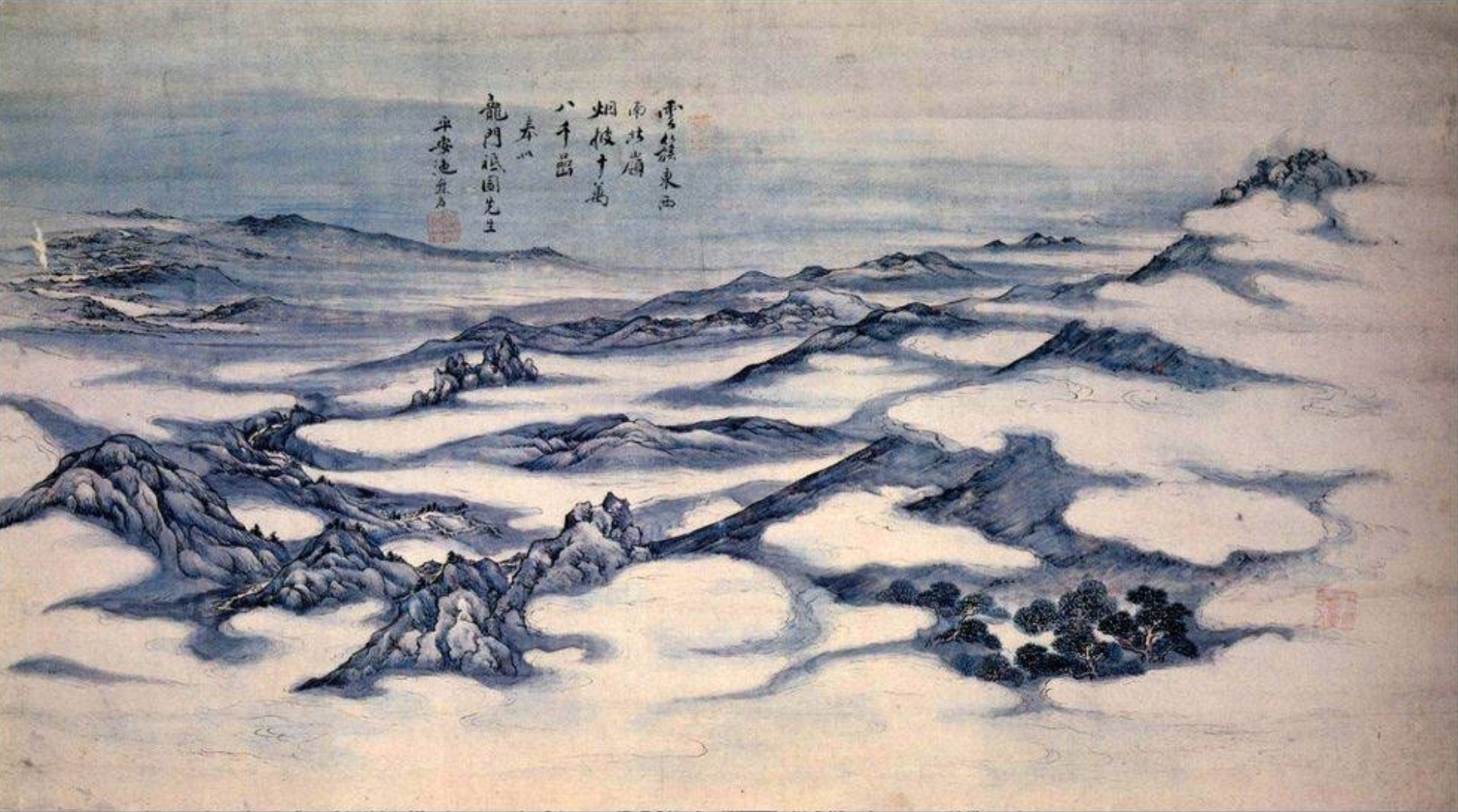
Taiga, True View of Mt. Asama, inscribed with a Chinese-style poem ink and color on paper, Edo period, 1760
True view means it will show something realistic, as if you’re seeing it through your eyes
Japanese site paired with a Chinese poem
nanga
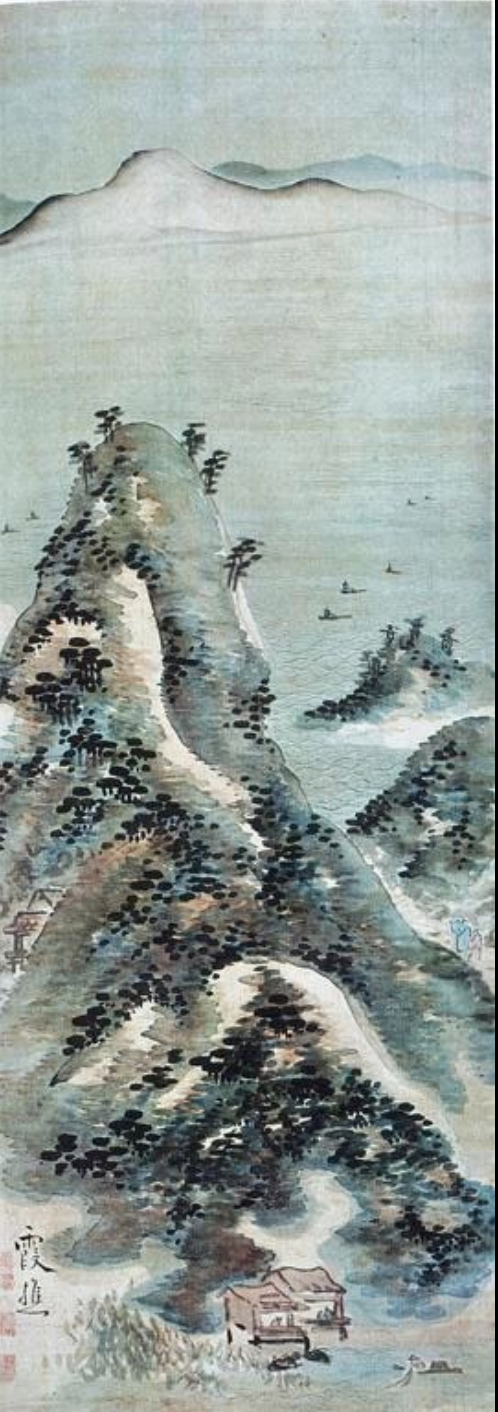
Taiga, True View of Kojima Bay, hanging scroll, ink and color on paper, Edo period, ca. 1760
Mi-style (a prominent chinese style) dots technique for the trees
Japanese site/subject in a Chinese style
nanga
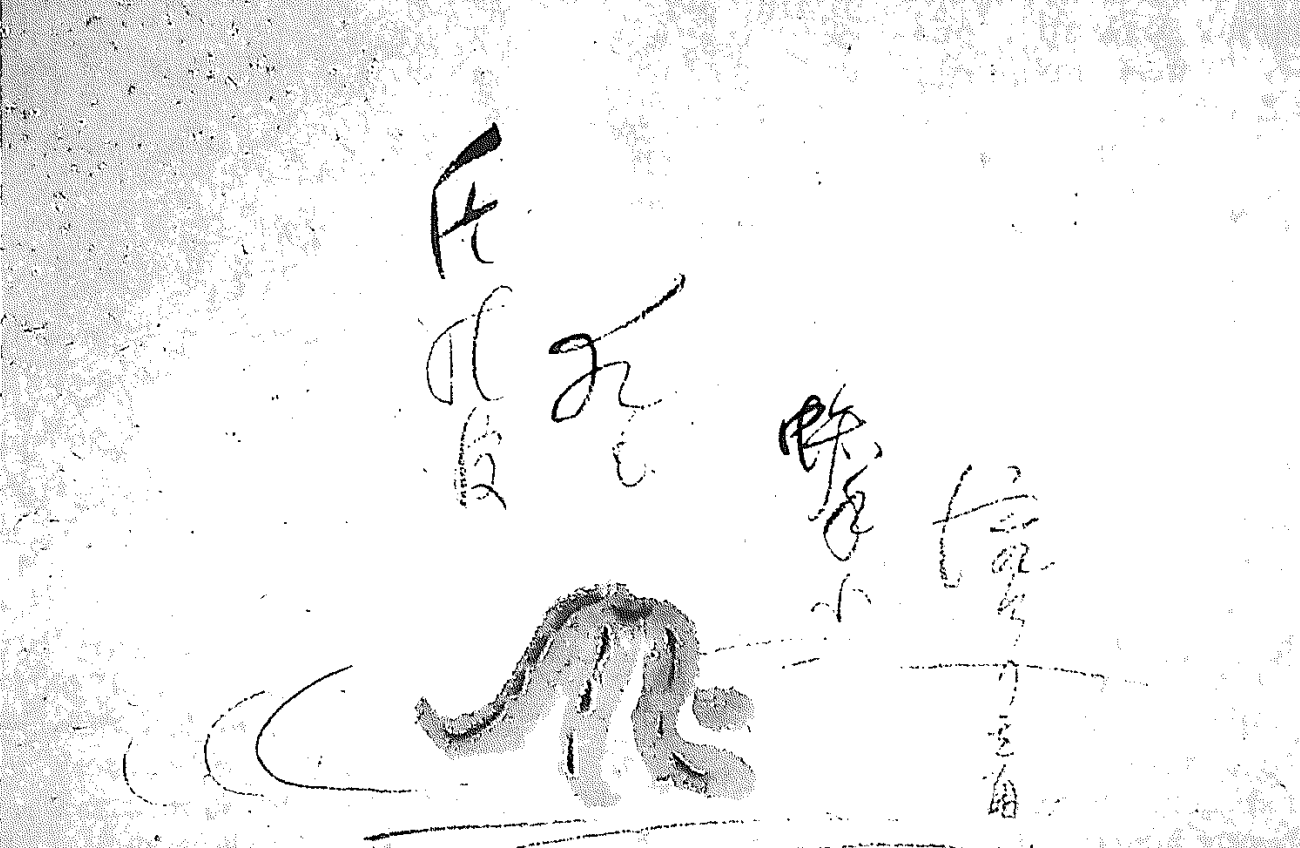
Kikaku, Melon Skin, haiga, ink on paper, Edo period
He depicts the most tawdry of objects, a section of melon rind floating down a stream
Just like the subject itself, this is a painting that viewers could easily pass by, in search of something more rare, grand, and colorful
Yet, this unglamorous subject, simply rendered with freely flowing calligraphy, allows Kikaku to express his fresh poetic vision of ordinary life
The painting helps to illuminate the scene, as Kikaku shows that someone had cut the melon in sections in order to eat its fruit
Now these sliced sections of skin gradually spread out and bob on the water
Haiga is the illustration that accompanies haiku (5-7-5 syllable pattern)
Haiku is indigenous to japan, thus so is haiga
The calligraphy is incorporated into the image, it's not separated from the image
Indicates a stronger relationship between the two
A mundane object that invites the viewer to think more deeply about this mundane object that people may typically overlook
Haiga was not created to be sold, thus it is not a commercial artwork (Southern school)
Unlike Rinpa and other professional artworks that were very commercial and meant to be sold (Northern School)
It’s more of a personal expression of the artist’s emotion, much more personal and intimate, much more evocative
Likely is rooted in Zen/teahouses
An irrational connection between melon skin and spider legs floating on the water
A Zen principle
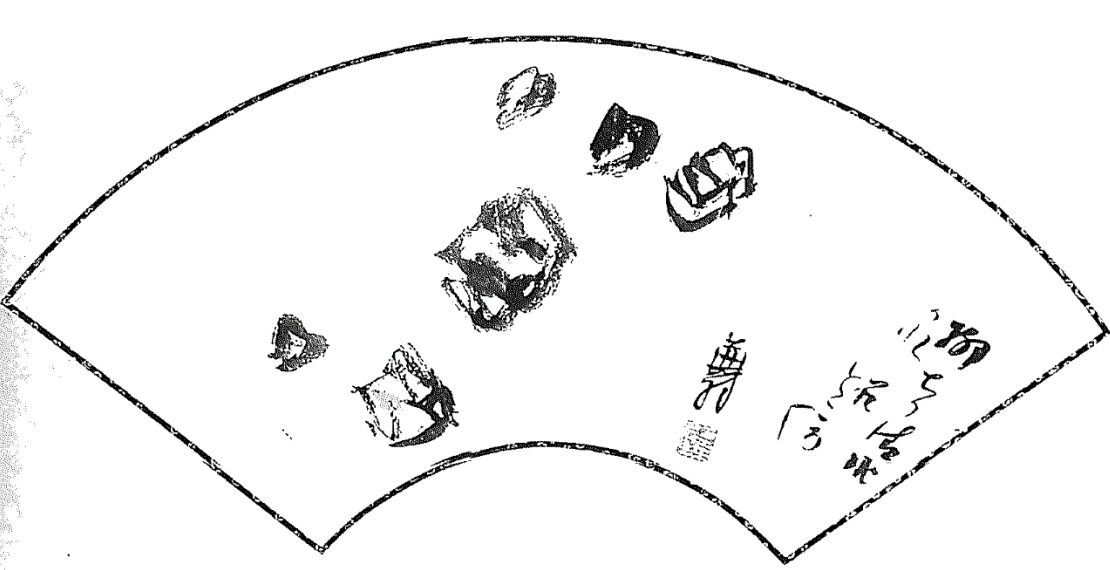
Buson, Rocks Fan, haiga, Edo period
He often painted rocks, sometimes allowing them to float freely over the surface of the painting with no anchor to the reality of ground and gravity
Despite the simplicity of the rocks, they carried with them multiple allusions to Chinese and Japanese poets of the past

Buson Recluse’s Cottage in a Bamboo Grove, 1770s Pair of 6-panel screen paintings
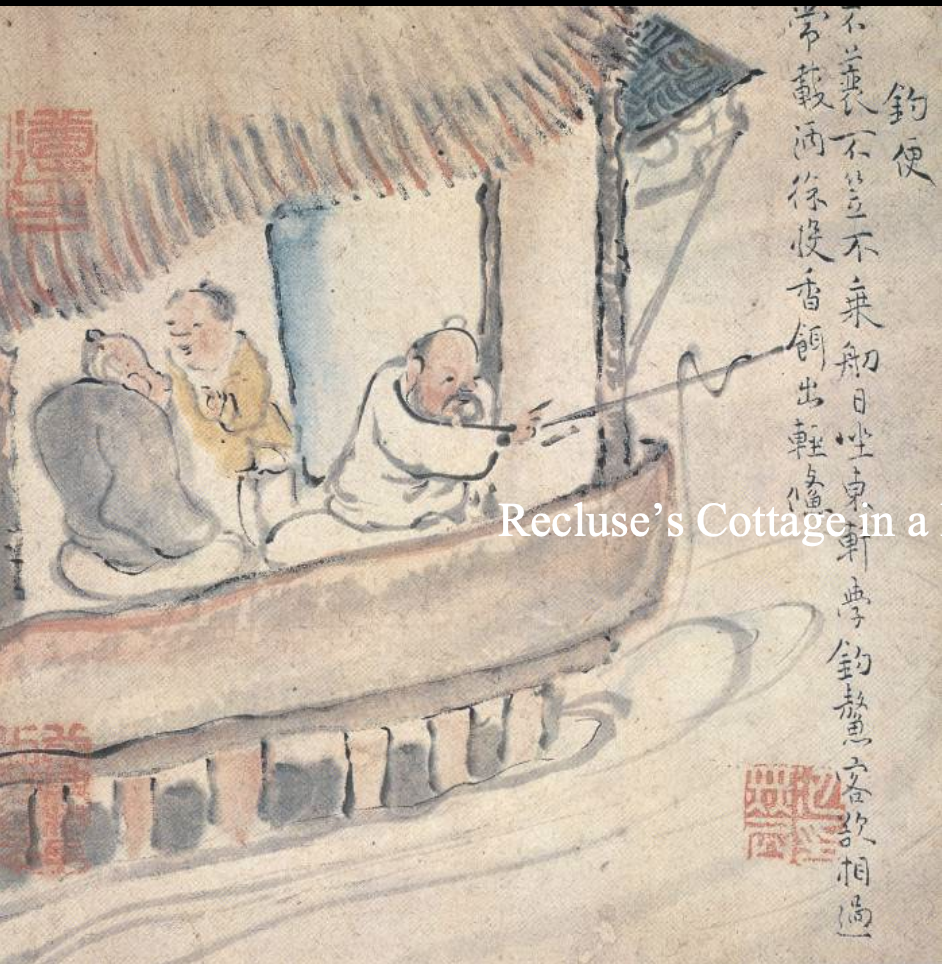
Buson-Taiga Collaboration Illustrating Li Yu’s (Chinese, 1611-1680) Poems of Ten Pleasures and Ten Conveniences: Taiga’s Ten Conveniences: The Convenience of Fishing 1771
Sketchier brushstroke
More zoomed in, a bit up close
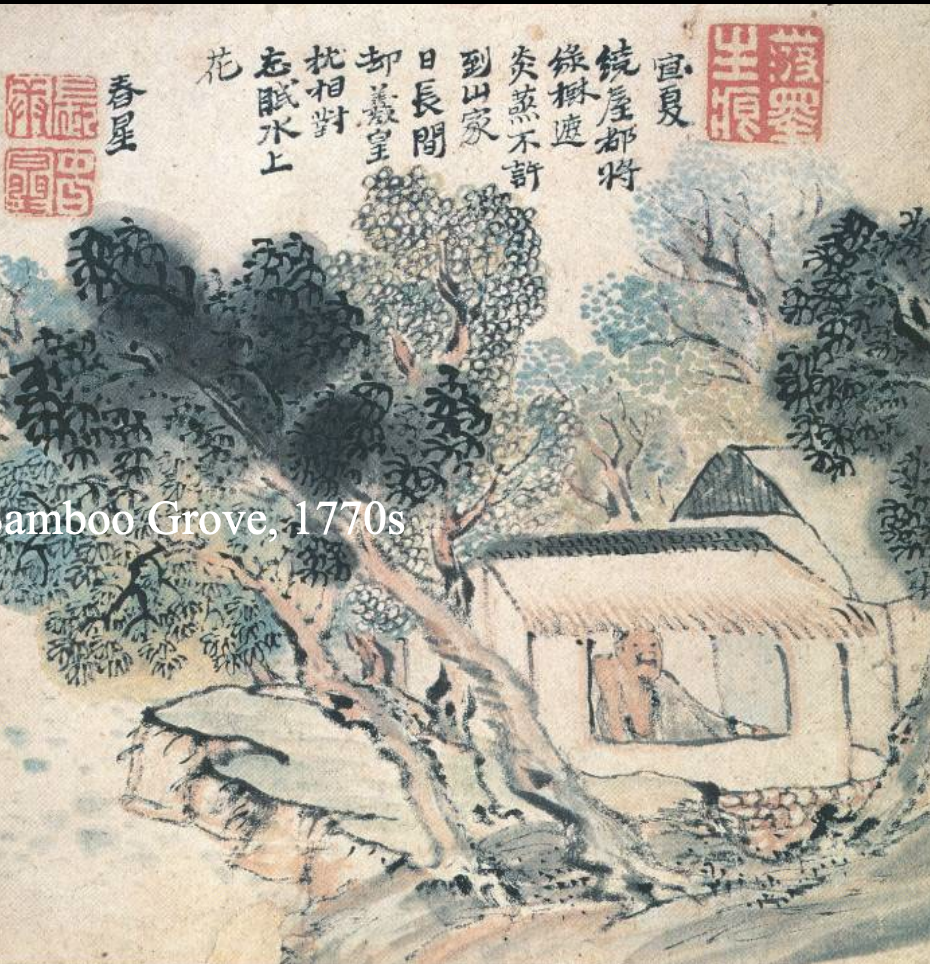
Buson-Taiga Collaboration Illustrating Li Yu’s (Chinese, 1611-1680) Poems of Ten Pleasures and Ten Conveniences: Buson’s Ten Pleasures: The Pleasure of Summer, 1771
More zoomed out

Buson-Taiga Collaboration Illustrating Li Yu’s (Chinese, 1611-1680) Poems of Ten Pleasures and Ten Conveniences: Taiga’s Ten Conveniences: The Convenience of Reciting Poems, 1771
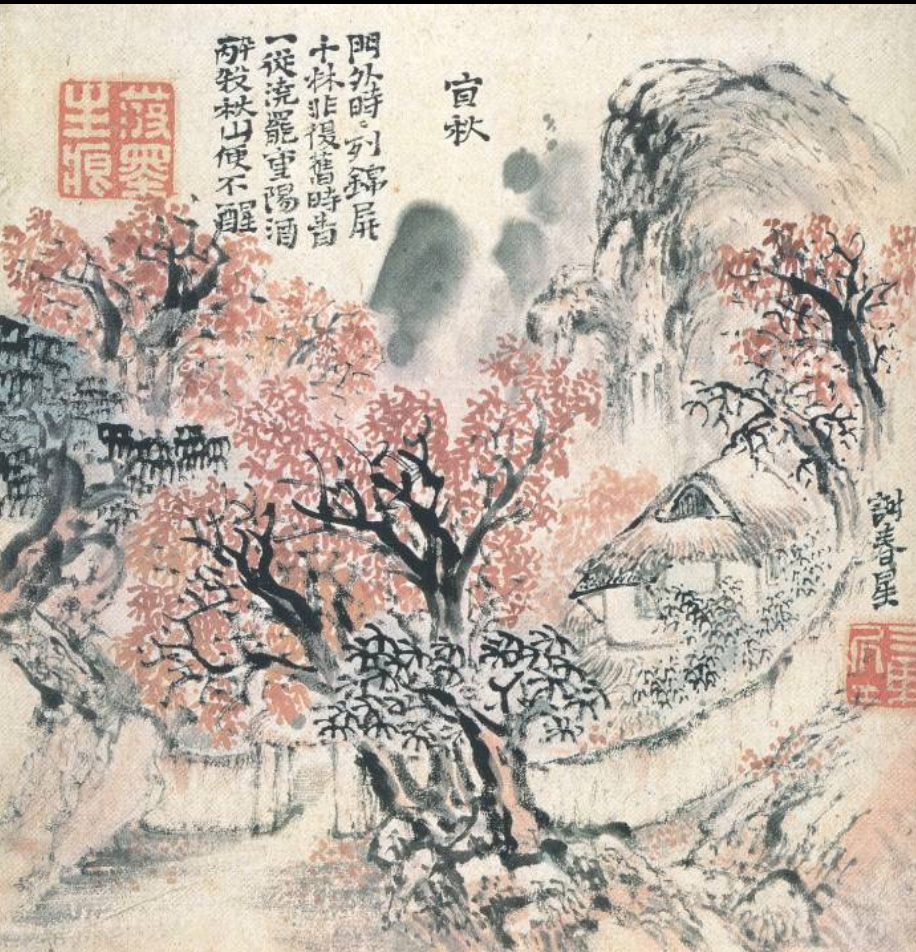
Buson-Taiga Collaboration Illustrating Li Yu’s (Chinese, 1611-1680) Poems of Ten Pleasures and Ten Conveniences: Buson’s Ten Pleasures: The Pleasure of Autumn, 1771
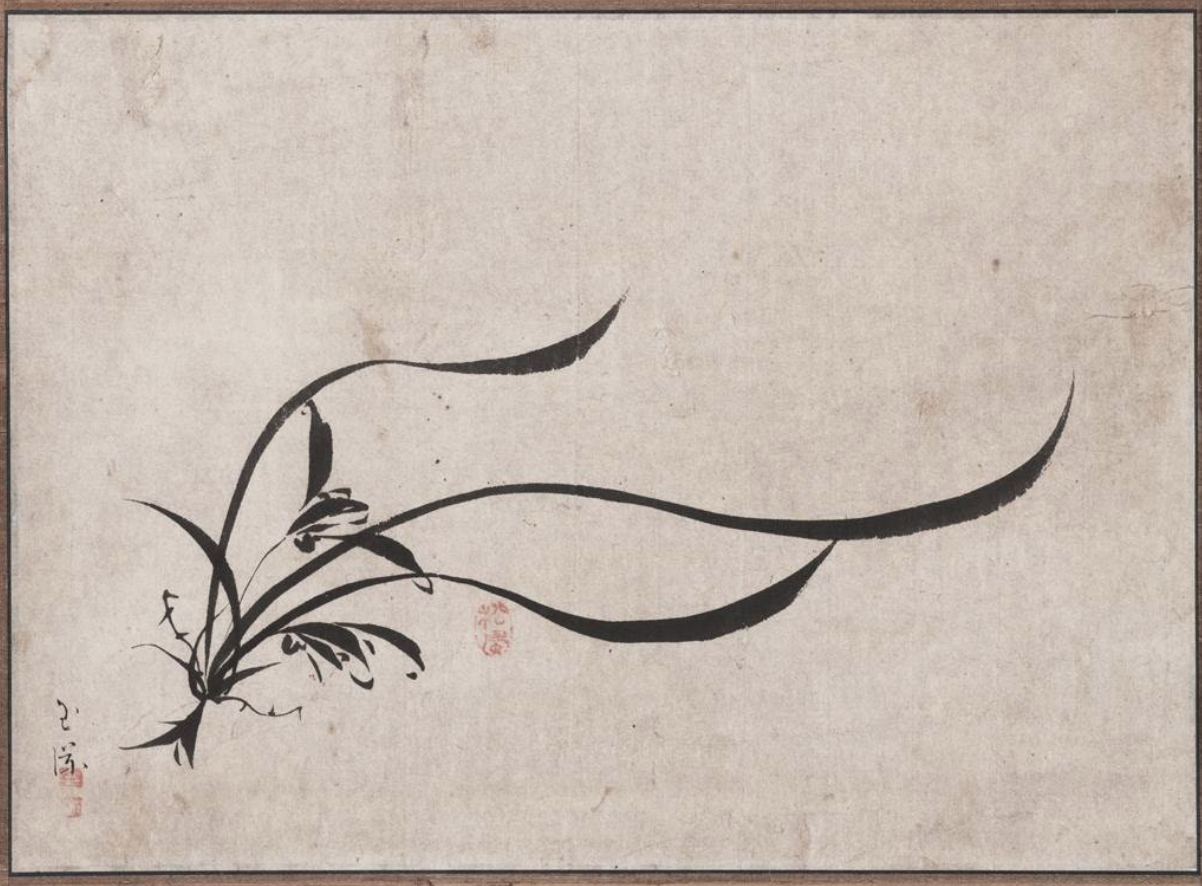
Gyokuran, Orchid, ink on paper, late Edo period
three broad brushstrokes to create the leaves
With two going in the same direction and one going in the opposite direction
Orchids as a subject
Symbolic of the integrity of your high character, regardless of social status/class
Shows the purity of your mind
Orchids were largely painted by women
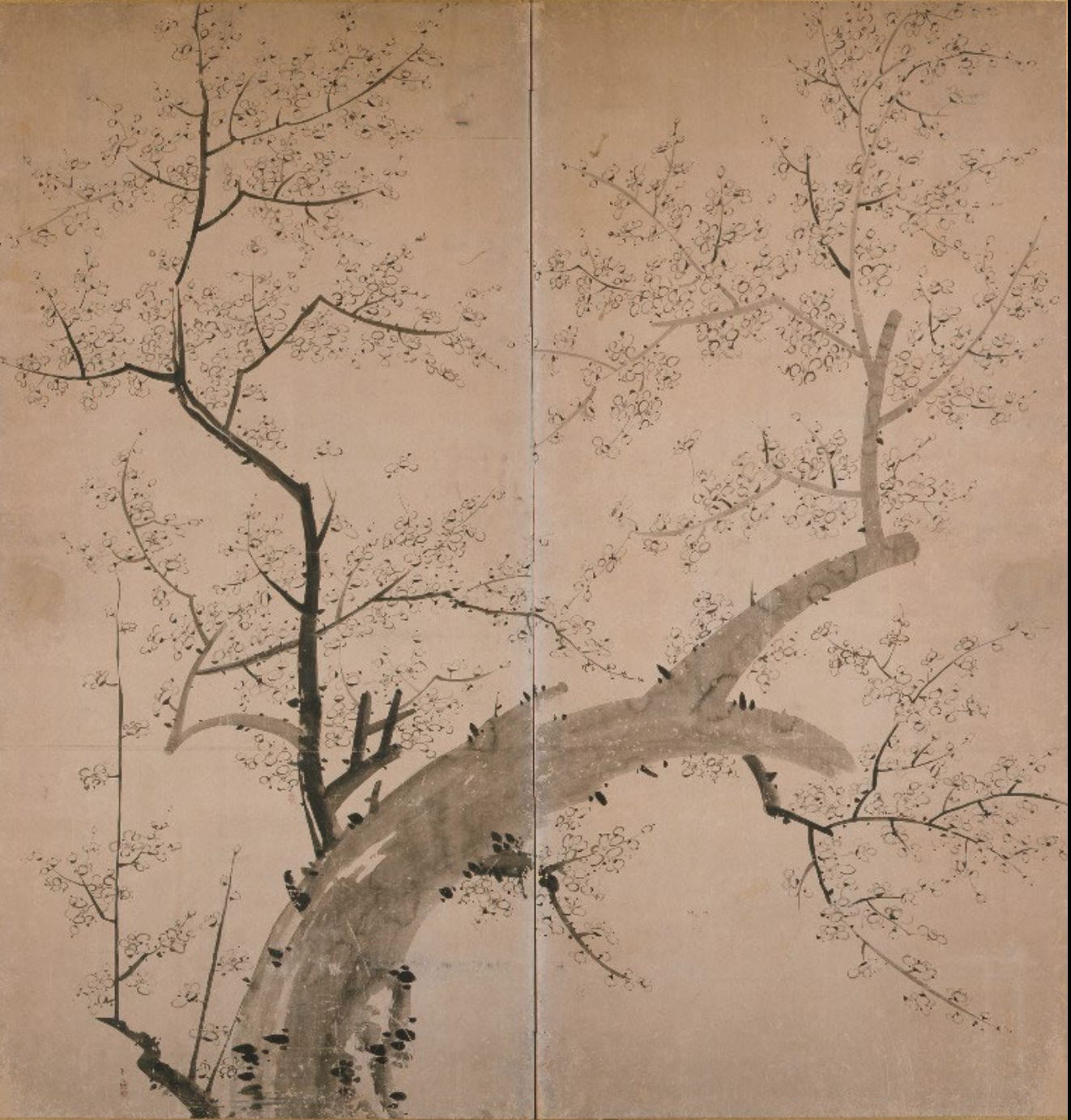
Gyokuran, Plum Blossoms ink on paper, Late Edo period
Depicts an old tree trunk with new leaves and blossoms
Refers to someone who is old (old tree trunk) but still has vitality (blossoms)

Gyokuran, Landscape, ink and color on paper, Late Edo period
Landscapes were considered the most ambitious kind of painting
In order to be considered a successful/respected artist, you need to paint a landscape

Chō KŌRAN, Landscape in the Mi Style, ca. 1830
Under Chikuto’s influence Koran also began to explore the literati landscape tradition, as can be seen in this painting
Like the works associated with Mi Fu, a chinese master of the Sung dynasty, Koran’s painting features mountains composed of overlapping layers of repeated horizontal dots
This work is not dated, but on the basis of style and signature it must be a work of her early career
After placing a foreground bank and a grove of trees at the bottom, she arranged the layers of mountains along a vertical axis, occasionally interspersing plateaus and areas of mist-shrouded houses and trees
By using a range of ink tones from light gray to black, she created a feeling of moist atmosphere and lush foliage
The repetition of similarly shaped mountain forms and brushstrokes establishes a sense of unity and stability
At the same time, the layering of short horizontal strokes creates a shimmering surface pattern
Mi Fu style: (a prominent chinese style) dots technique for the landscape
Used in this case for the trees and mountains
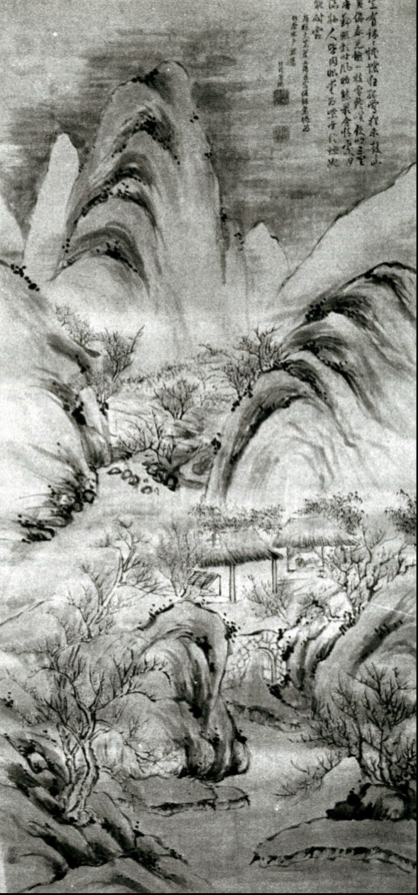
Cho Koran, Plum Villa Landscape for Kido Takayoshi, ca. 1875
Its focus on the elegant beauty of blossoming plum trees dotting the hillsides
By this time her husband had already passed away
Her new patron and friend: Kido Takayoshi
He’s wealthy art collector
A very ambitious painting

Kōran, Plum Blossoms, 1876
This painting in monochrome ink emphasizes the toughness of the old tree with its battered trunk and branches
Both the painting and poem communicate the idea that blossoms last only a moment, but the tree endures
more tied and connected to the poem
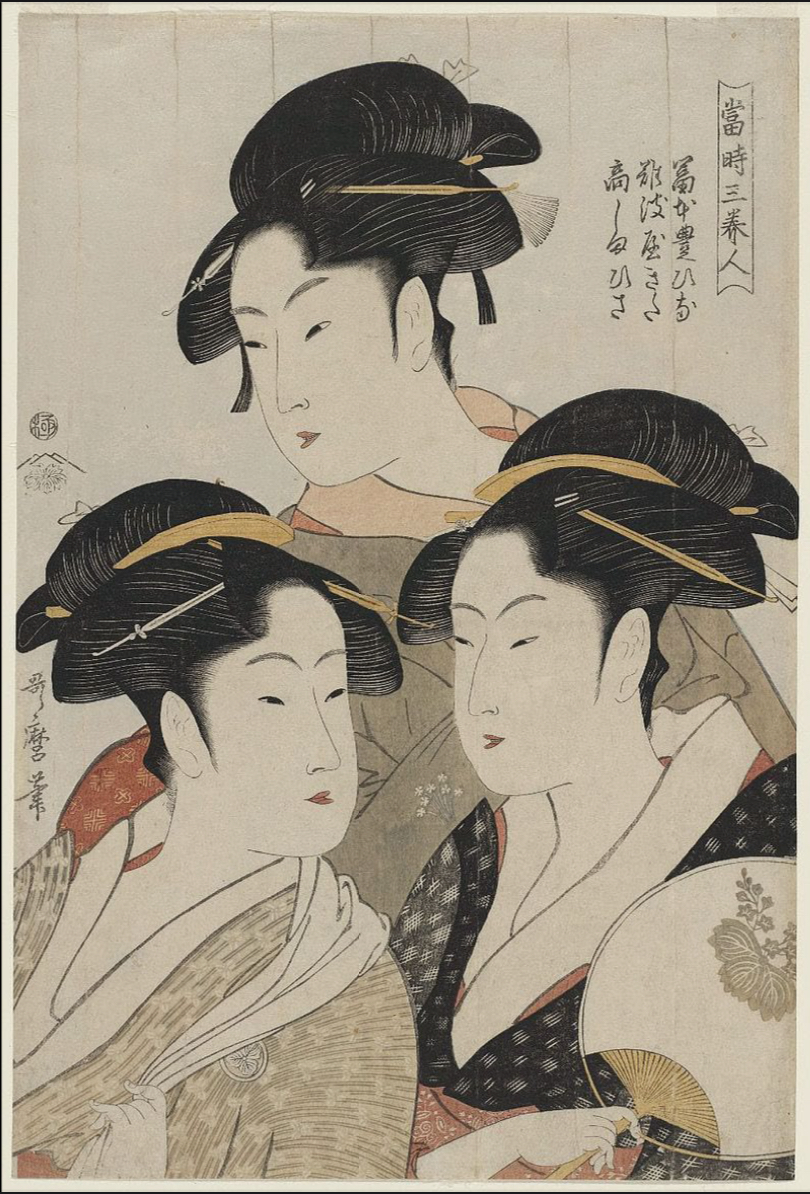
Utamaro, Three Beauties of the Present Day: Tomimoto Toyohina, Naniwaya Kita, Takashima Hisa, 1793, ōkubi-e
Kind of similar to the Heian “line for the eye and hook for the nose”
The women look identical
The three women’s names are identified by their individual flower crests
“oriental beauty”

Utamaro, Woman of the Coquettish type, from the series "Ten physiognomic types of women" c.1791
Shows a close-up view of a woman just out of the bath; although her hair is meticulously piled up, her kimono is carelessly worn and the sash is loosely tied
The background has been rubbed with mica to produce a silvery grey, which highlights the warmth and softness of the fleshtones
His typical beauties are long and willowy and have about them a languid and sensual air (as seen in this painting)
A lot of the appeal of these prints is their sensual nature
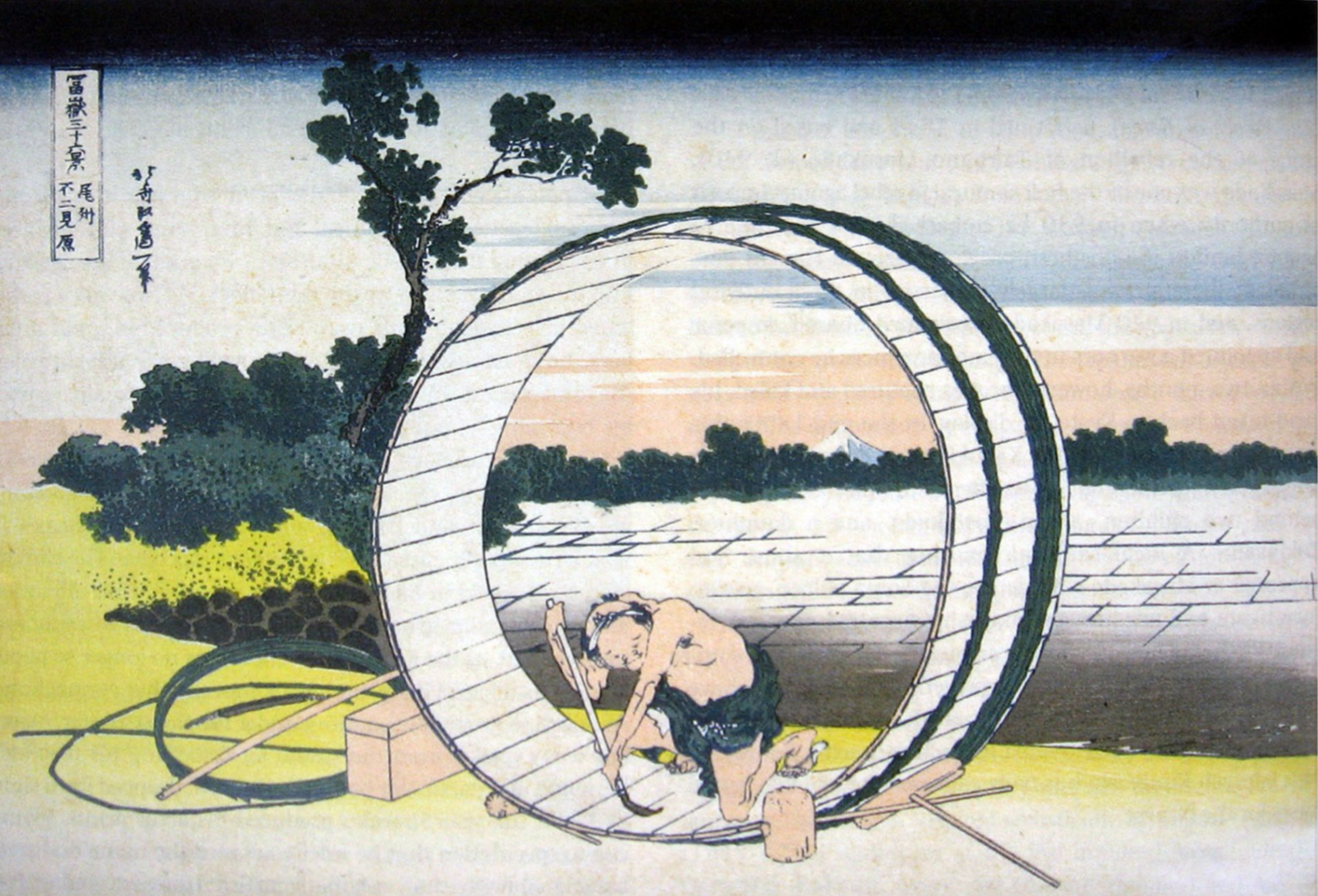
Hokusai, View of Fuji from the Rice Fields in Owari Province (#9), 36 Views of Mt. Fuji, 1830-33
Artists encouraged to travel to these locations in order to depict them
Very local which makes people love it
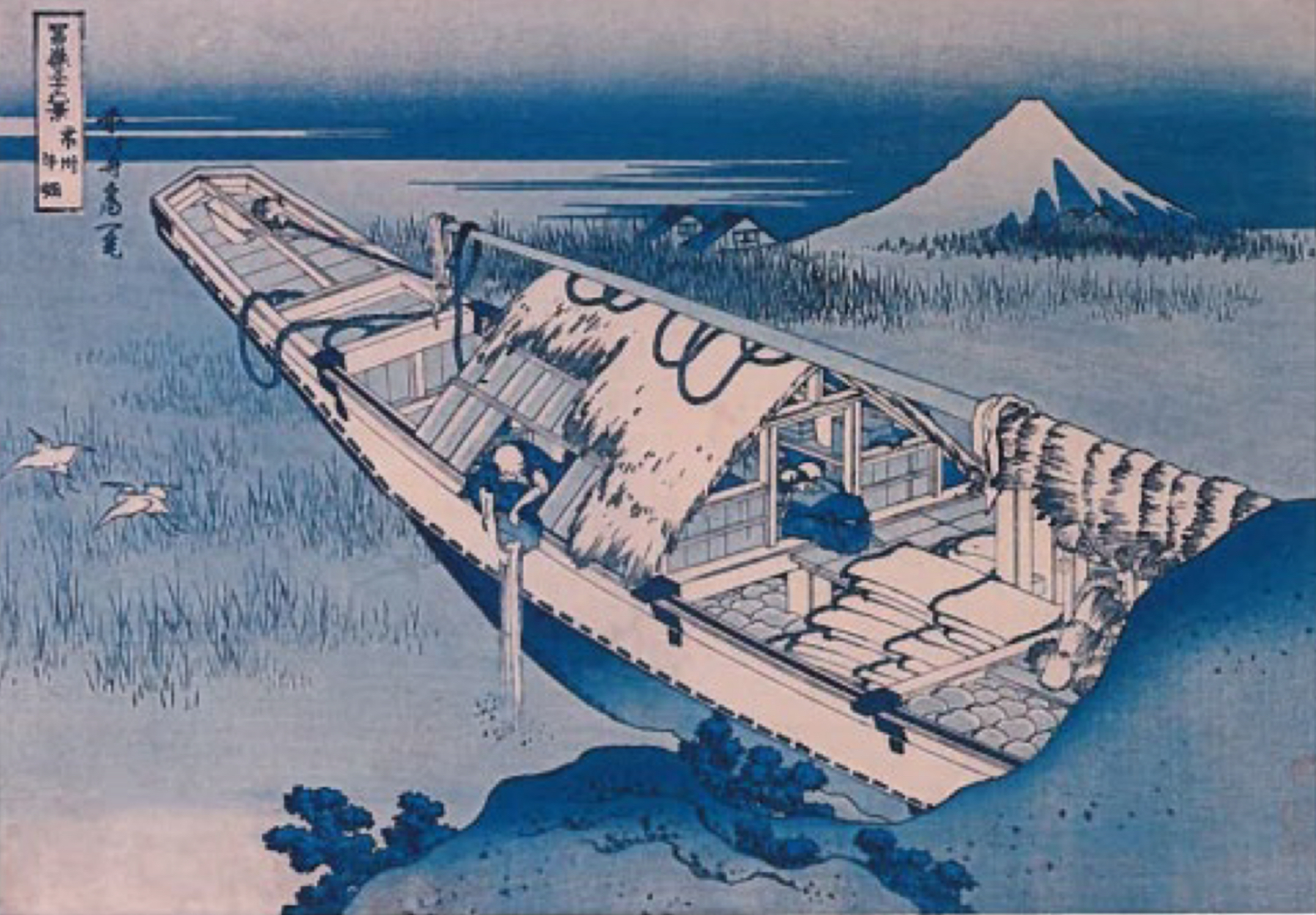
Hokusai, Ushibori in Hitachi Province (#20), aizuri-e, 36 of Views of Mt.Fuji, 1830-33
Aizuri-e: monochromatic blue prints
aizuri-e and Prussian blue
Prussian blue was a European synthetic pigment
Proved suitable for woodblock printing, and it extended the palette of blue hues that had been limited to the organic pigments of indigo and dayflower blue
More vivid and didn’t fade, also viewed as exotic, thus more appealing to the public
Contains Prussian blue
A European synthetic pigment, not organic
The more blue you have in your print, the more appealing it was

Hokusai, South Wind in Clear Weather (Red Fuji) (#2), 36 of Views of Mt.Fuji, 1830-33
Known for the strong, reddish-brown iron oxide coloration of typical impressions
The southern wind and thin trails of snow are phenomena of late summer
Bands of white clouds drift across a striking blue sky
Its impressions where the sky is lighter, it appears to recede behind the mountain, thus creating a greater illusion of volume in the mountain itself
Hokusai helped make Mt. Fuji become apart of the Japanese national identity, not just the Edo identity
So bold, so monumental, and never seen before
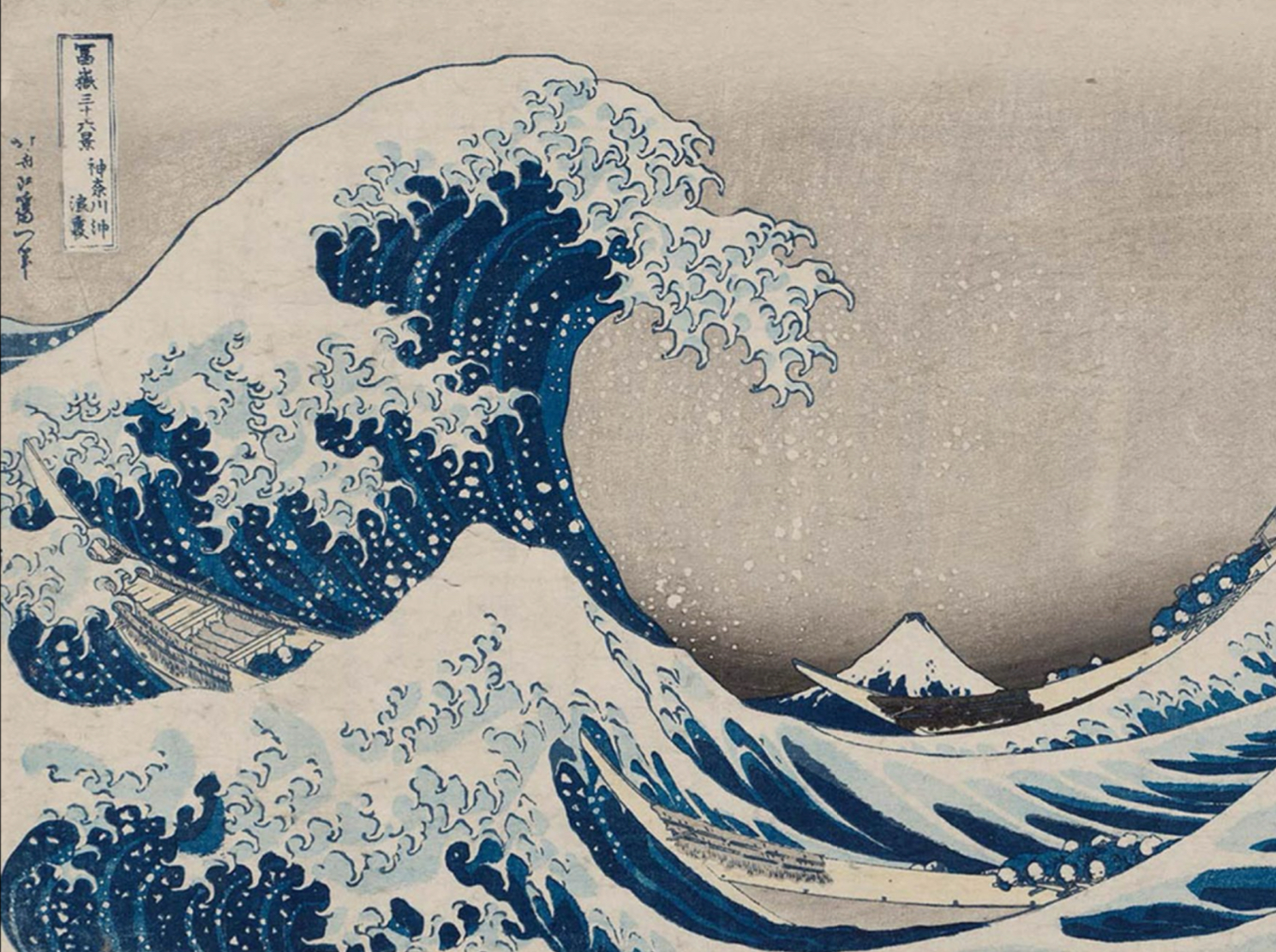
Hokusai, Under the Wave off Kanagawa (#1), aizuri-e, 36 Views of Mt. Fuji, 1830-33
His most famous artwork
Reveals a variety of block carving and printing techniques
Undulating lines of varied thickness delineate the top of each of a series of waves, while irregular, slightly interrupted patterns of curving lines form the stylized, claw-like crests of the breaking waves
Mt Fuji, with a heavy cap of snow, is silhouetted by a dark grey sky
It's about to engulf three boats of terrified fishermen
An image about Japan facing an uncertain and unstable future during their period of isolation
There was a big fear of invasion by sea
Creates an element of dread and uncertainty
Particularly with the claw-like details of the wave
A hybrid of Japanese and Western art
Commercial appeal
Historical context of the uncertainty of Japan’s future
Looming threat of invasion from the sea by foreigners
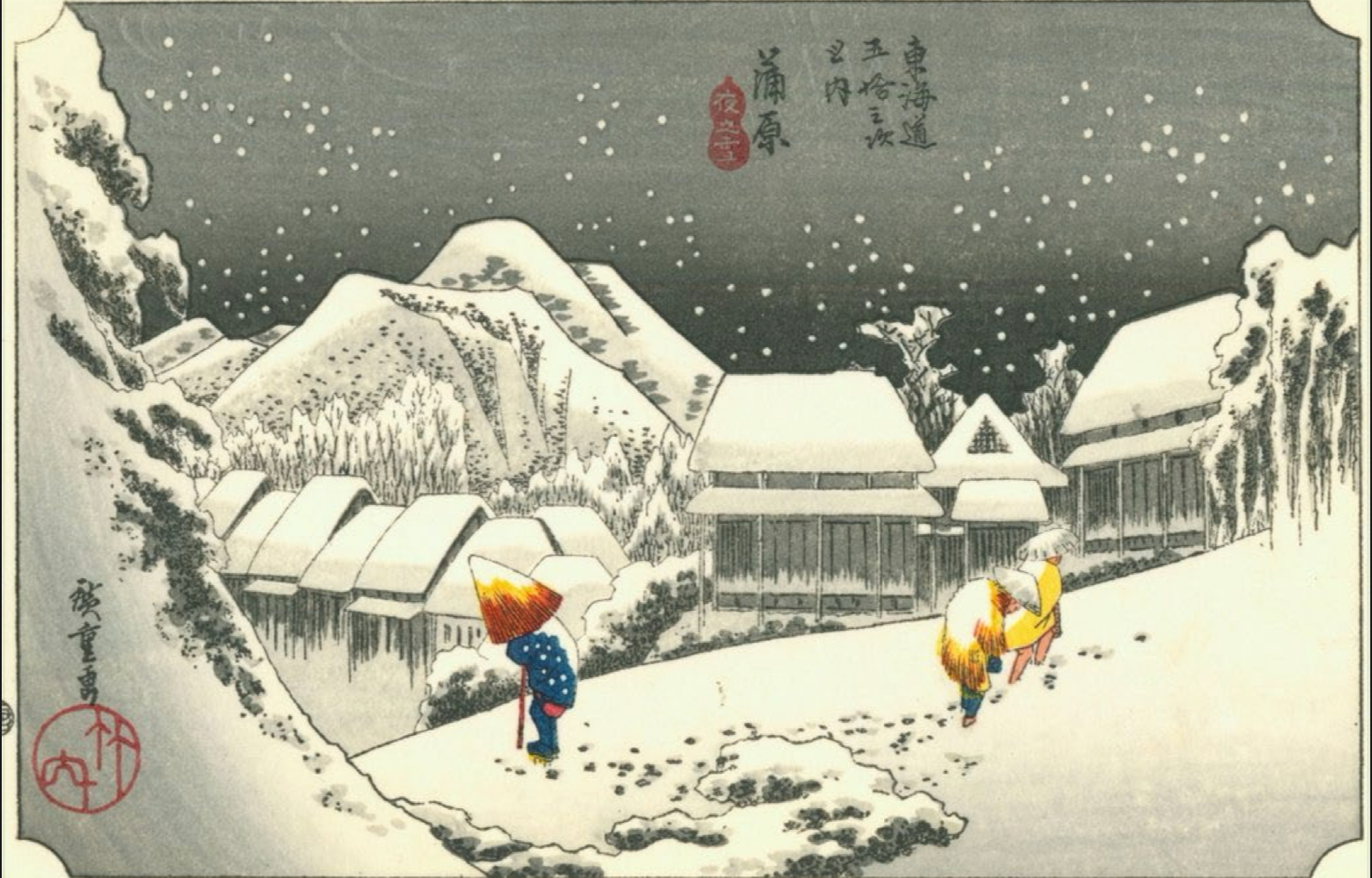
Hiroshige, Snow at Kambara (#15), from 53 Stations of the Tokaido, 1833-35
A focus on the people and local customs along the East Coast Highway
Travelers in an evening snow
Strong diagonals
Asymmetrical
Travelers going in different directions
More realistic
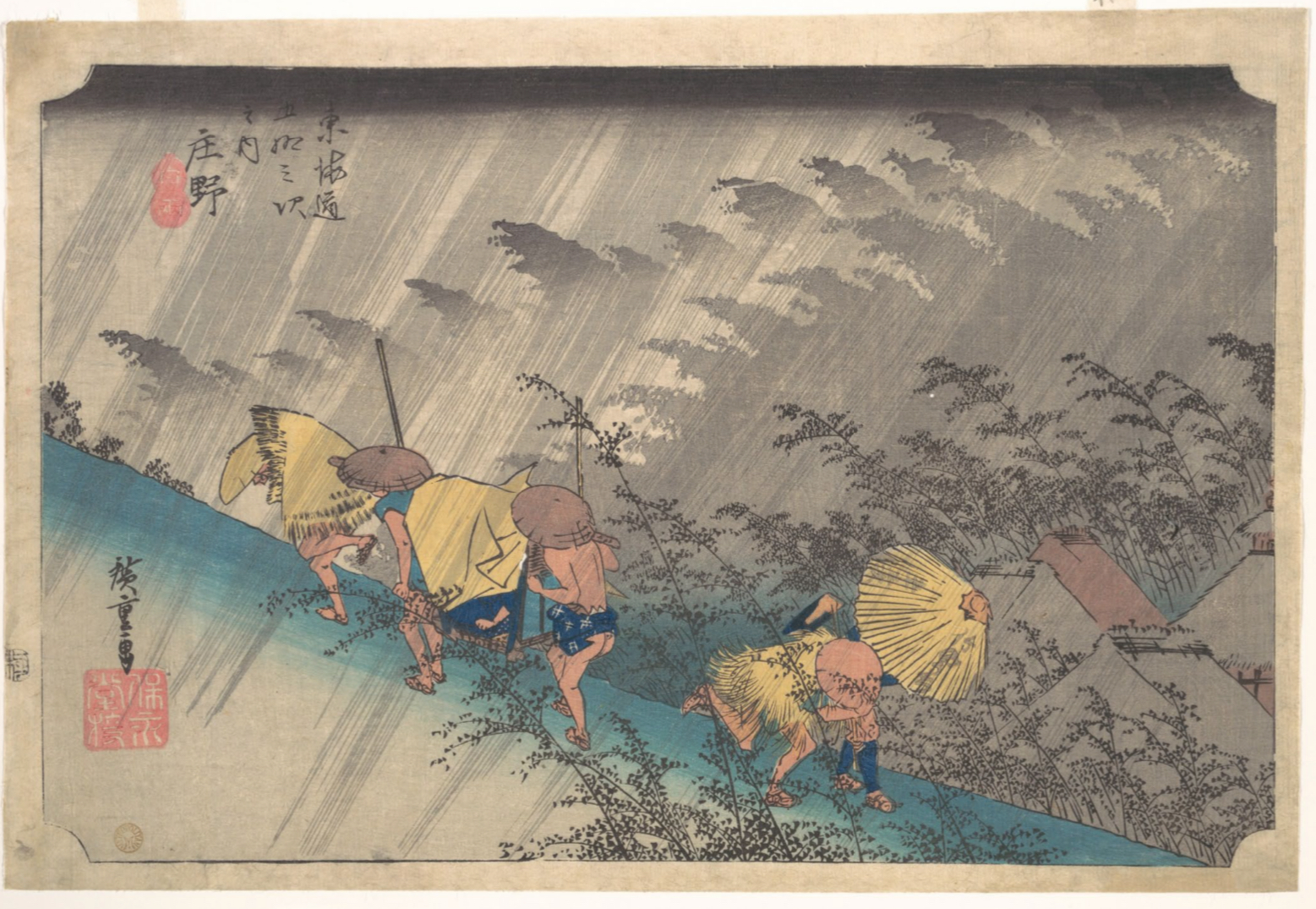
Hiroshige, Rain Shower at Shōno (#45), from 53 Stations of the Tokaido, 1833-35
Must be in the summer
echoes/repetition in the background of trees
Repetition of the same motif shows that it has decorative value
Strong diagonals
Diagonals of rain
Diagonals of trees going in the opposite direction
Travelers going in opposite directions
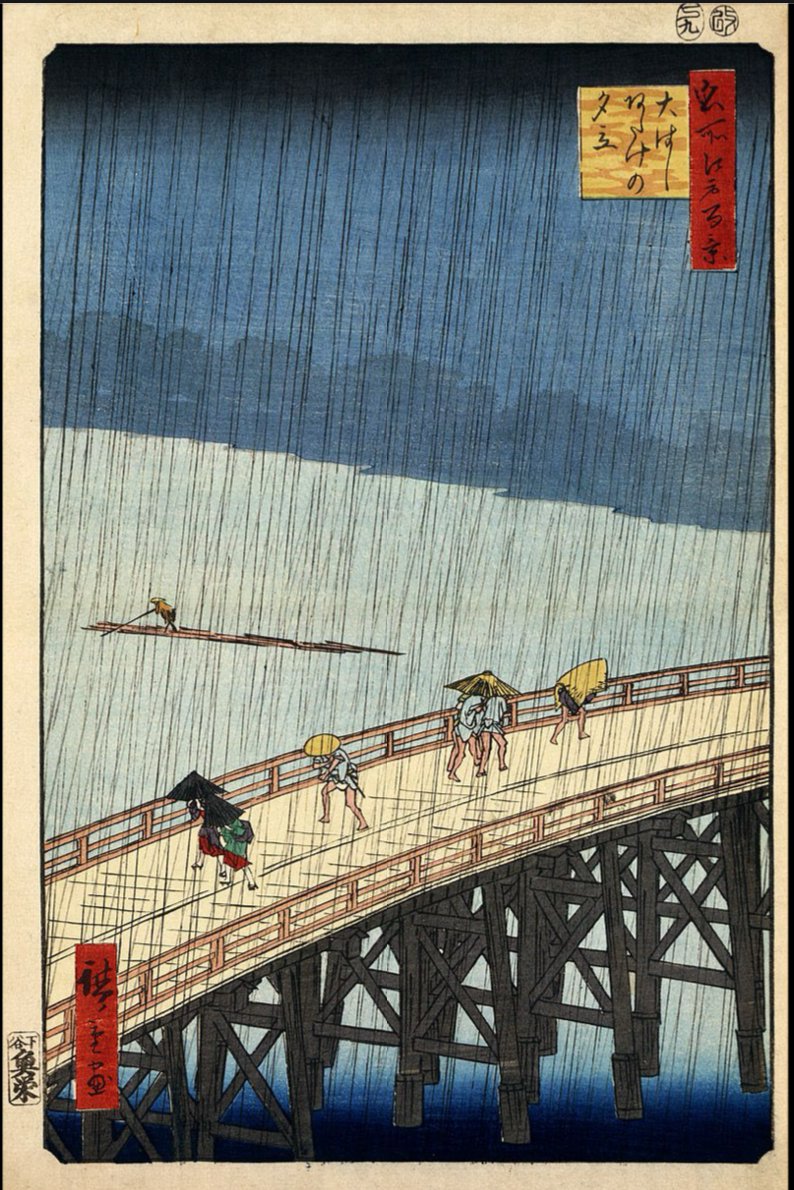
Hiroshige, Rain Shower over Ohashi Bridge and Atake (#30), from 100 Views of Edo, 1848-58
Travelers going in opposite directions
Prussian blue at the top and bottom of the print
Diagonals
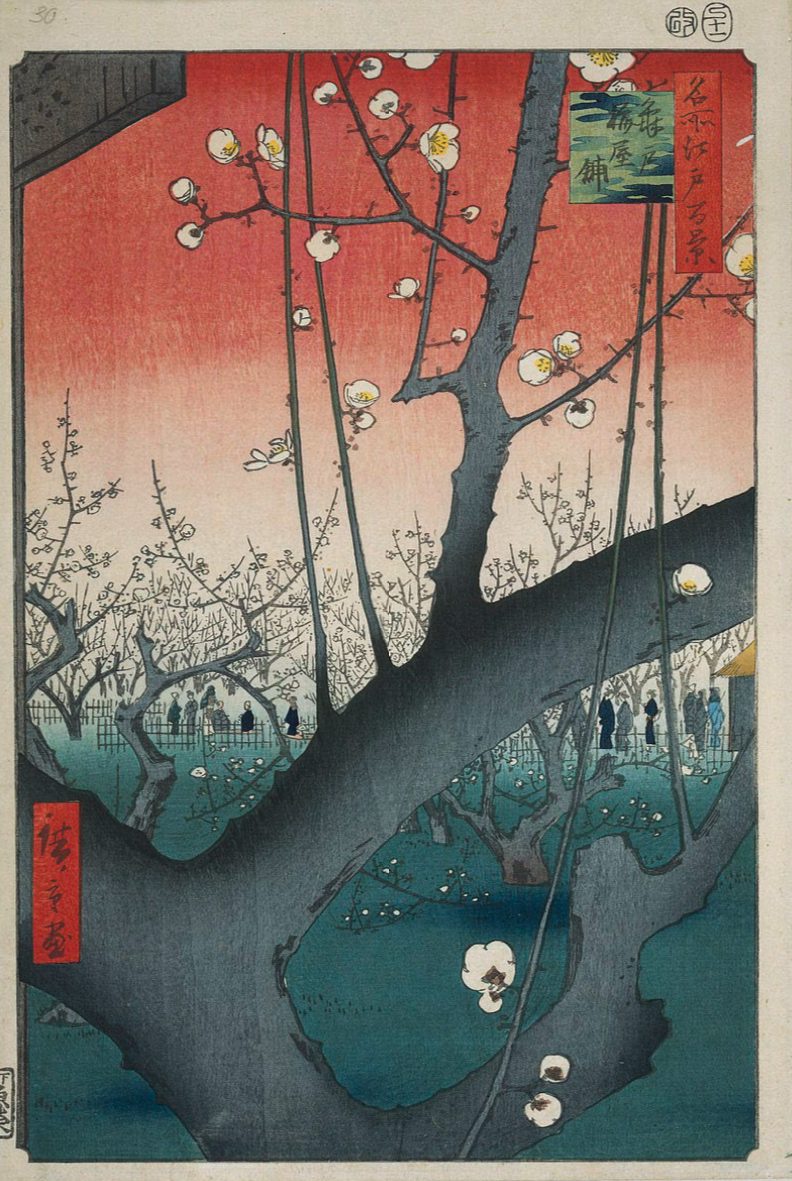
Hiroshige, The Plum Garden in Kameido (#58), from 100 Views of Edo, 1848-58
Strong diagonal
Interesting perspective from the tree

Kuroda, Morning Toilette, 1893, yoga
caused a minor furor by publicly exhibiting a painting of a nude for the first time in Japan
Illusion of the mirror: an image within an image
A very French taste
Scandalous for depicting a fully nude woman
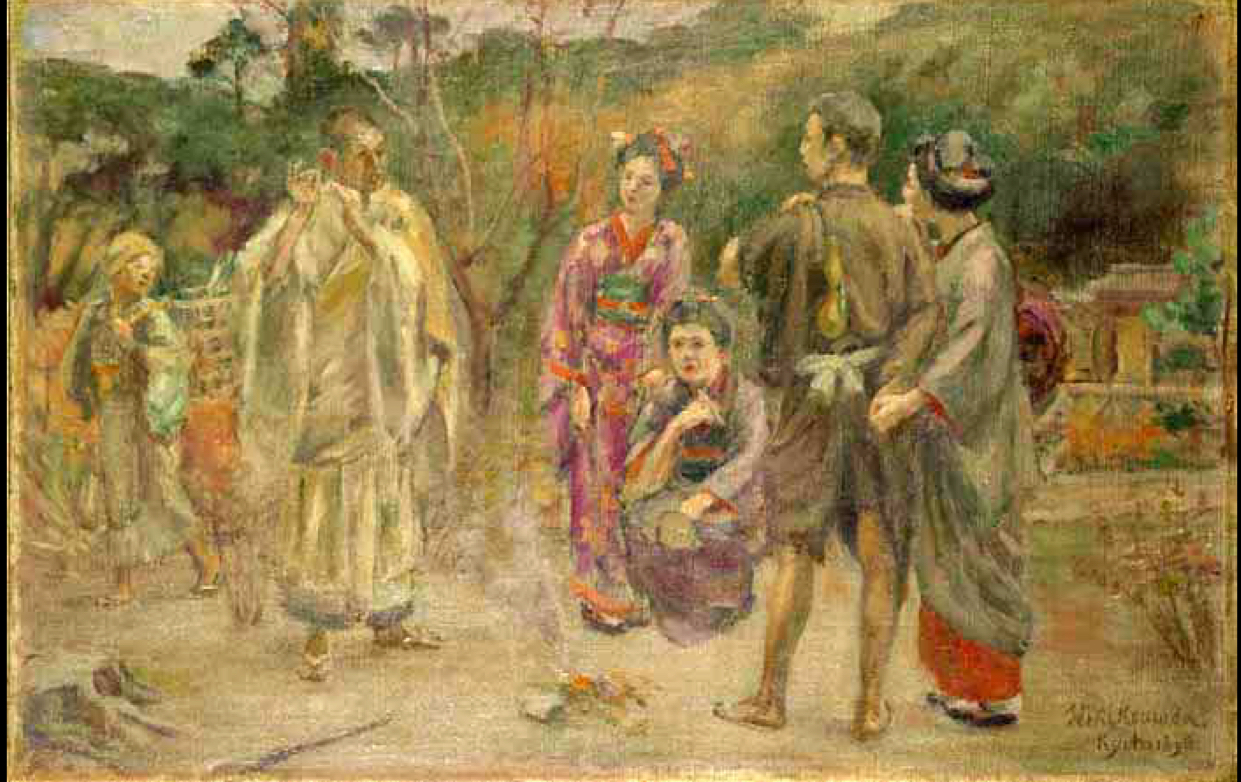
Kuroda, Study for Talk on Ancient Romance (Composition II), oil on canvas, 1897, yoga
Where he attempted “grand scale painting”
It is clear in his mind, that kosoga must involve historical narrative as its subject, and he planned for groups of people posing in a landscape
The subject matter for such a painting should express eternal values of love, peace, or courage, and in this context, the depicted human figures in the painting are best portrayed in the nude, since clothing invariably reflects a particular historical and cultural background
There was strong public opposition to paintings of nude figures
The Meiji government in 1873 prohibited nudity in public
A westernized style on a Japanese ideal of narrative storytelling
Compre: David, The Oath of Haratii, 1784 (L)
Both show a female figure crouching down
Both depict a story/narration
Both are historical paintings
L is a tragic story
When people come back from studying in Paris, they attempt to make a historical painting
Historical paintings are held in the highest regard/respect in Europe

Kuroda, Lakeside, oil on canvas, 1897, yoga
Shows a woman resting by a lake after bathing
An ingenious treatment of late 19th century French composition with the aura of Japan’s unique courtesan-prints
Something new, yet still Japanese
The color palette is very muted, and the brushstrokes are quite visible
Very Impressionist
The woman is Japanese and in Japanese garb
She’s not high class, but still comes across as very confident
Very modern
Nature background
Inspired by yamato-e

Kuroda, Triptych of Wisdom (right), Impression (center), Sentiment (left), 1899 Oil on canvas, yoga
The key words of Japanese culture
Wisdom
The only figure facing the viewer
The gesture is balanced and rational
Symmetrical
The hair is tied up
Quite Roman, refers to modesty
The woman is more mature
Both Impression and Sentiment figures are in a ¾ position, turned facing towards the middle
Sentiment
Has long hair worn down, usually associated with emotions
Similar to how the Princess Nyosa in Tale of Genji wears her hair down
A very emotional response
Similar in posing to Greek sculptures
One hand is in her hair
The three nude female figures is similar to the Three Graces in a 1st century fresco at Pompeii
Thus, the triptych is quite western
The hairstyles are different
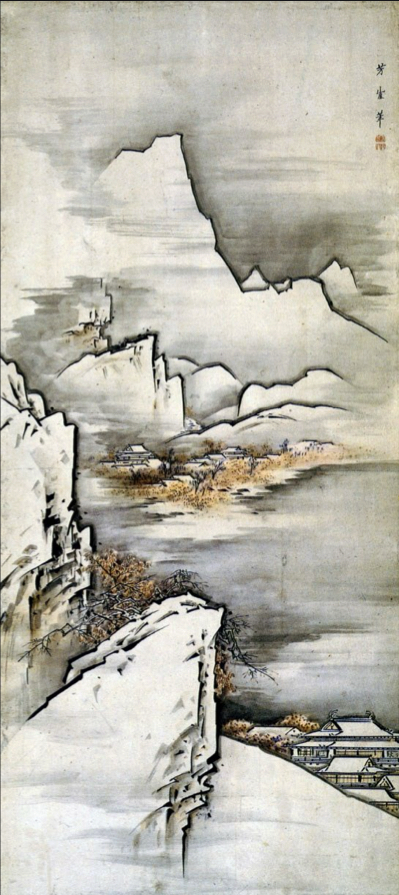
Hogai, Landscape in Snow, hanging scroll, ink and color on paper, Meiji, 1867
A Kano school traditional landscape painting
Made before he met Fenellosa
Similar to Sesshu’s Landscape of four seasons: Winter
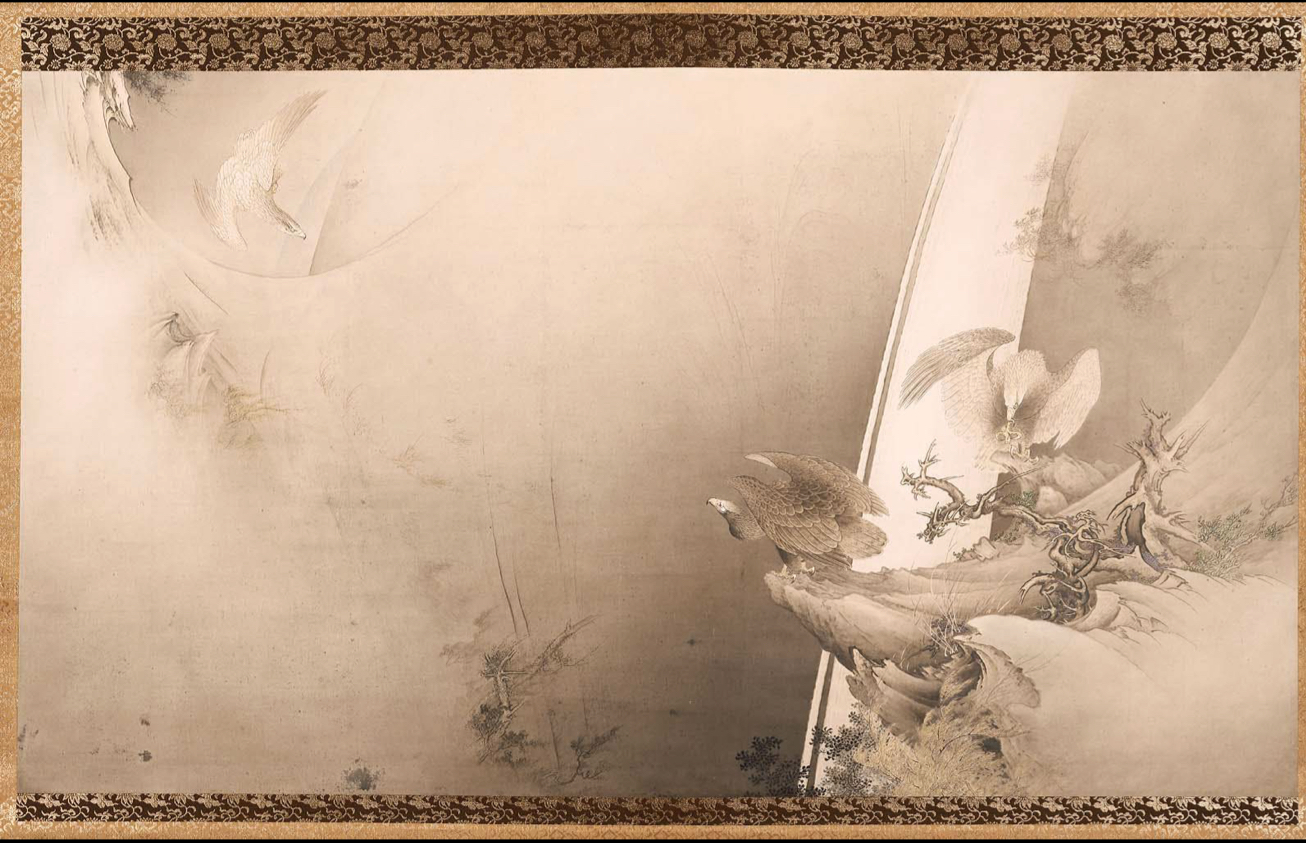
Hogai, Eagles in a Ravine, hanging scroll, ink and color on paper, ca. 1885-86, Nihonga
Considered the first Nihonga painting
A Japanese/traditional subject
Western techniques
The white, flat, stripe is a waterfall
Kinda abstract
Very naturalistic
The detail of the eagle’s feathers almost creates a pattern that echoes the Rinpa school
A mix of so many elements (Chinese, Japanese, Western, Modern, Traditional styles)
There’s a small diagonal of the top of the trees that ties the eagle on the left to the eagles on the right

Hishida, Fallen Leaves (Ochiba), pair of 6-panel screens, mineral pigments on paper, 1909-10, Nihonga
Combines Western realism with the poetry of space: trees seem to recede into an all-pervading mist, losing definition
Western linear perspective: there’s a clear foreground and background
Criticized for experimenting by not using line drawing
A clear and tangible light source
More western/modern
to some degree are related to the Kano school
repeat the same motif: trees
From Rinpa school
Very detailed
more of an observation of the trees/is more scientific and realistic

Bakusen, Abalone Divers (Ama), 1913 color on silk, pair of six-panel folding screens
Nihonga
The subject of half nude women is inspired by Western art
Japanese format of 6-panel screens
Depicts indigenous women fishing in the old fashioned way
Differs from the modern mass farming techniques that was popular at this time
The divers didn’t wear any clothes/protection whereas modern divers wore diving gear
Rinpa style of large/flat surfaces of color
Usually primary colors: blue, red, yellow
The subject itself derives from ukiyo-e eortic imagery while the social significance of labor is stressed by the figures’ activities
The figures on the right screen are shown at work, while the women on the left screen enjoy rest
Reminiscent of printing techniques are the glistening background covered with mica powder, the forceful colorism of the women’s brownish-yellow skin, the deep blue in their loincloths and in the sea, and the accents of green in the plants on the right screen
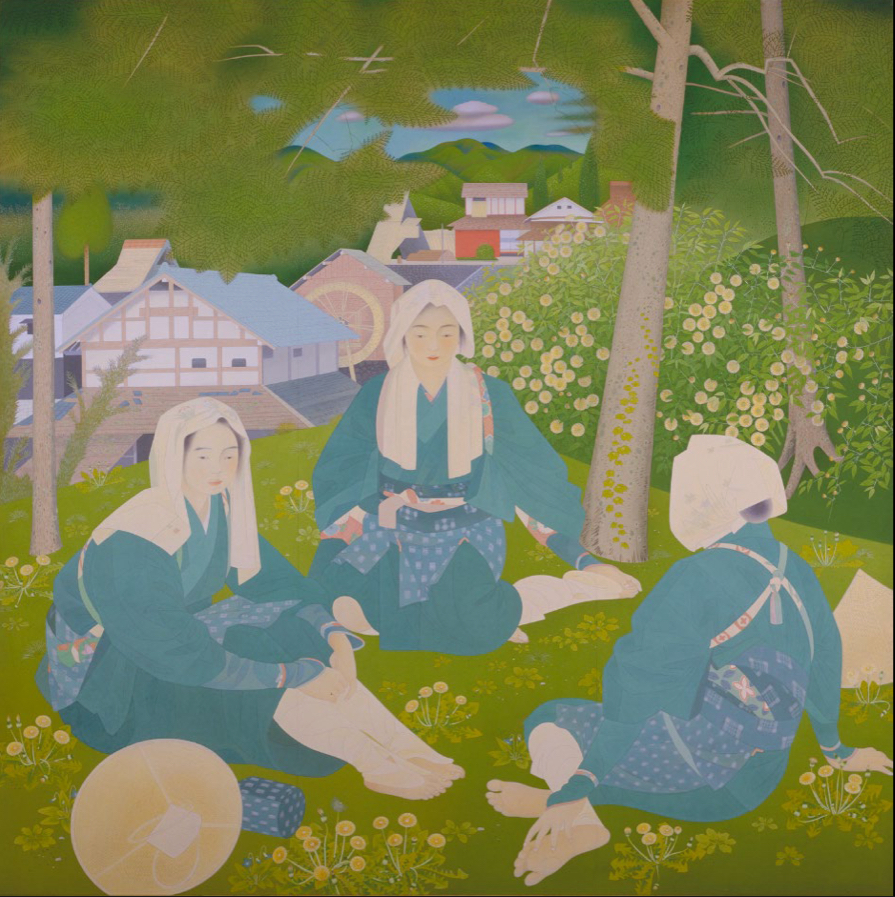
Bakusen, Obara Maidens (Oharame), 1927, color on silk/framed, Nihonga
An endeavor to challenge Western masterpieces
The frivolous encounter of naked women with fashionably dressed gentlemen is transfigured into innocuous folklore
The mixing of males and females is consciously avoided
Leisure seems to redeem the hardship of work
The approach is something like folk art
Focus on indigenous women
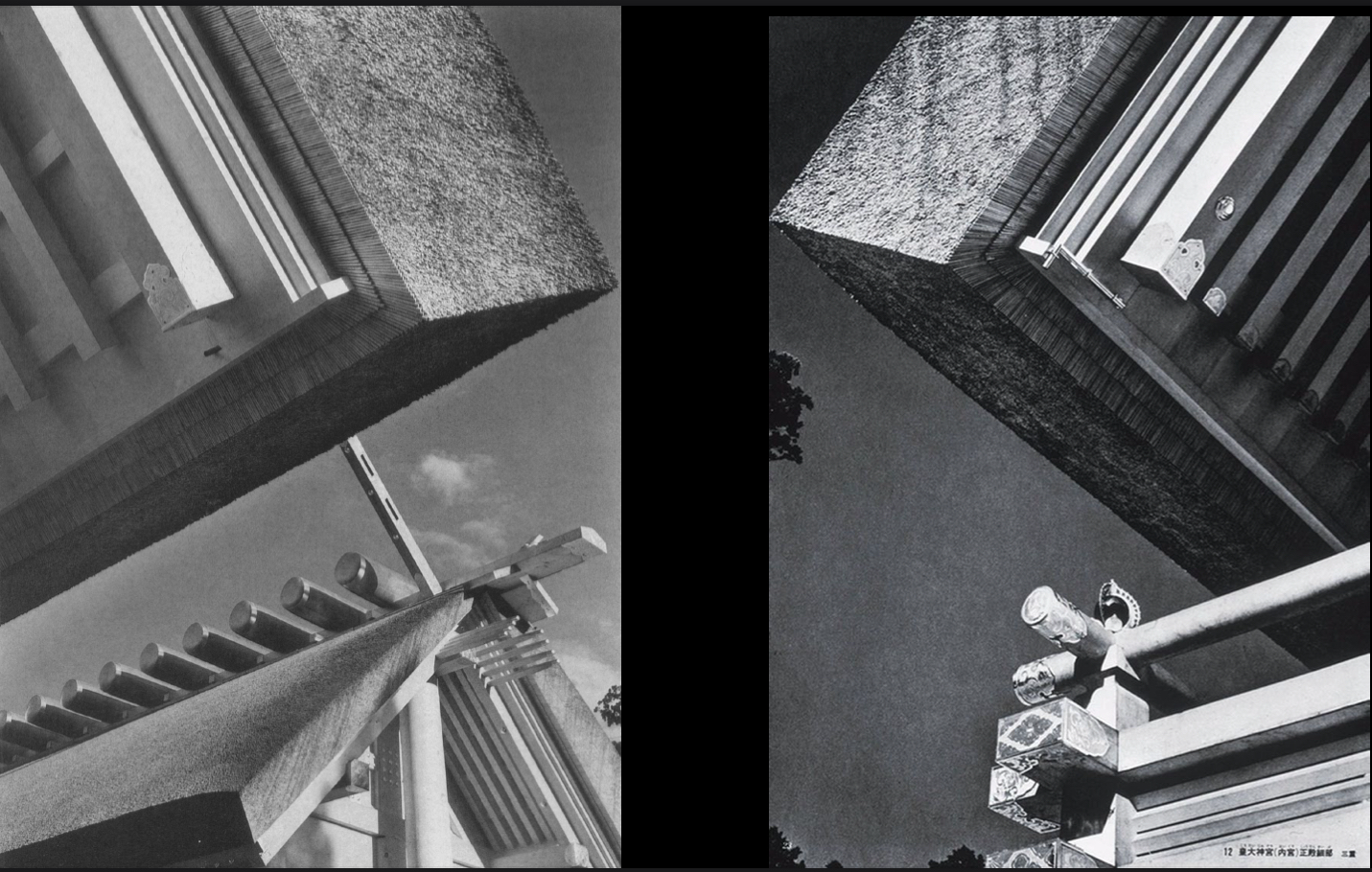
Watanabe, Ise Shrine, set of photos, 1953
These new photographs established an unprecedented level of intimacy and in doing so undermined the religious aura that had always shielded the shrines
At the same time, they enabled Tange and others to elevate the shrine buildings to a new position as the prototype for all of Japan’s later architectural achievements
The photographs of Ise chosen for the book were among the more “objective” images in the series
Intended to serve a “documentary function”
In each photo the camera angle was level with the ground and the camera was placed far enough away from its subject so that the photographs would depict entire buildings rather than fragments
The photos appear to function as tools for conveying information about the architecture rather than as an expressive medium for the photographer
In addition to the comparatively “straight” images, as well as extensive plans and elevations, were also comparatively “abstract” images
Even with few clouds to be seen, several of the photos were highly charged with emotion
The majority of the images were gathered together as a coherent portfolio
This portfolio has a narrative structure, designed to evoke the experience of visiting the shrines
Usually a visit to Ise involves sharing the experience with many others, yet not a single person appears in these photos
Noone is allowed to intrude on the viewer’s reverie
Contributed to the rebuilding of a Japanese identity after WWII
Yoshio made the Ise Shrine modern by changing the view of the shrine by using different kinds of camera angles to showoff certain details
Totally different view of Ise Shrine -> modern
A statement for modernity and modernization
The eye looking at the Ise Shrine is what changed, not the shrine itself
A sort of distorted angle to change something so primitive to something modern
Modern art is free from any reference
Modernism transformed Ise from an imperial object into an aesthetic object embodying moderity
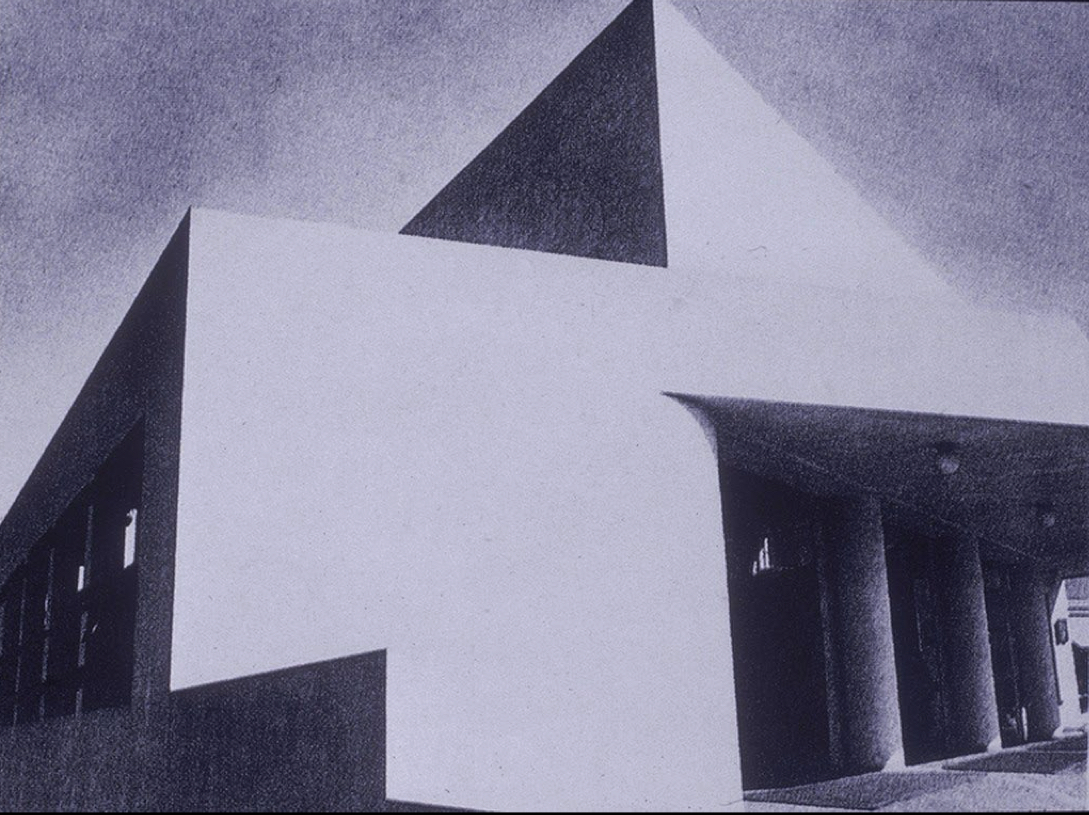
Watanabe, Ochanomizu Station, photo, 1933
His first published architectural photograph
Shot from a disorientingly low camera angle
Made use of dramatic contrasts of light and dark that tend to transform the architecture into relatively abstract geometric forms
The actual train station looks so ordinary
A move away from the pictorial image to a new and modern angle
The new camera angel makes it into something modern and dramatic using light and shadow
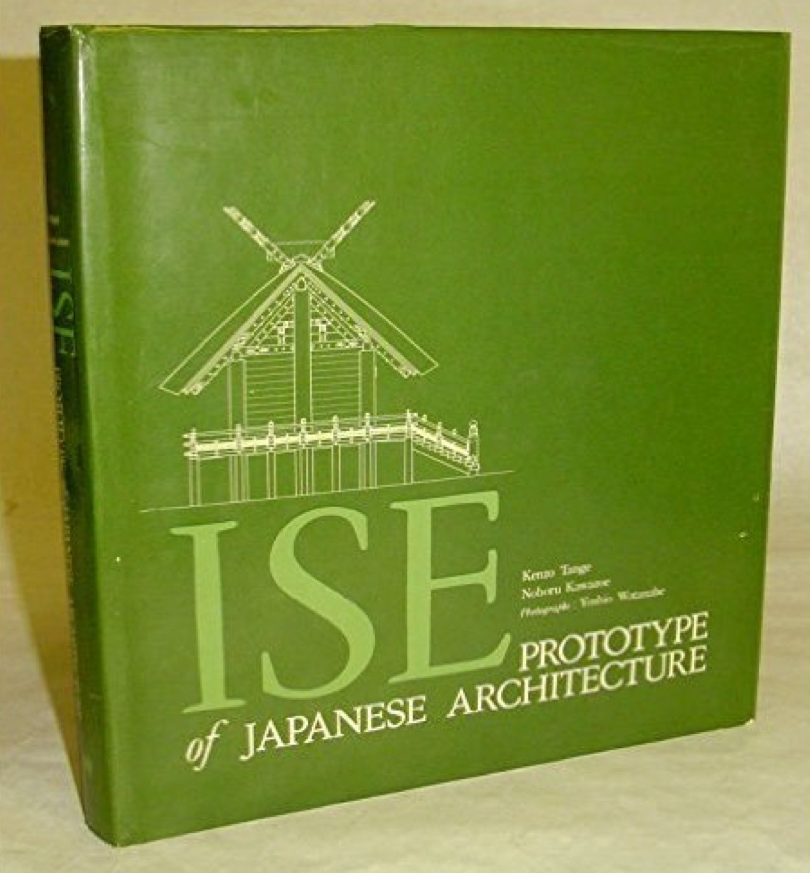
Ise: Prototype of Japanese Architecture Kenzō Tange and Noboru Kawazoe. Photos. by Yoshio Watanabe. Layout and book design by Yusaku Kamekura (MIT 1965)
Promoted the architecture at Ise even more aggressively by claiming a unique position for Ise as prototype for all later Japanese architecture
A highly selective interpretation of the shrine architecture especially well suited to the needs of the modernists communities in Japan and abroad
Emphasized the ancient origins of the shrines
“Nature” is the vehicle that allows Tange to travel into the remote past
Placed emphasis on architectural proportions and the harmony between Japanese architecture and “nature” and in doing so reproduced conventional modernist rhetoric about pre modern Japanese architecture
Tange believed that Ise, as the starting point for all later Japanese architecture, embodied the fusion of the Jomon and Yayoi styles
Argued that both modes of religious practice were still preserved at Ise
The presence of both Jomon and Yayoi cultures contributed to the depth and complexity to the Ise complex
Tang's impulse toward wild mystification in combination with his urge for seemingly more concrete historical argument
With the text, readers could imagine that through Ise they had
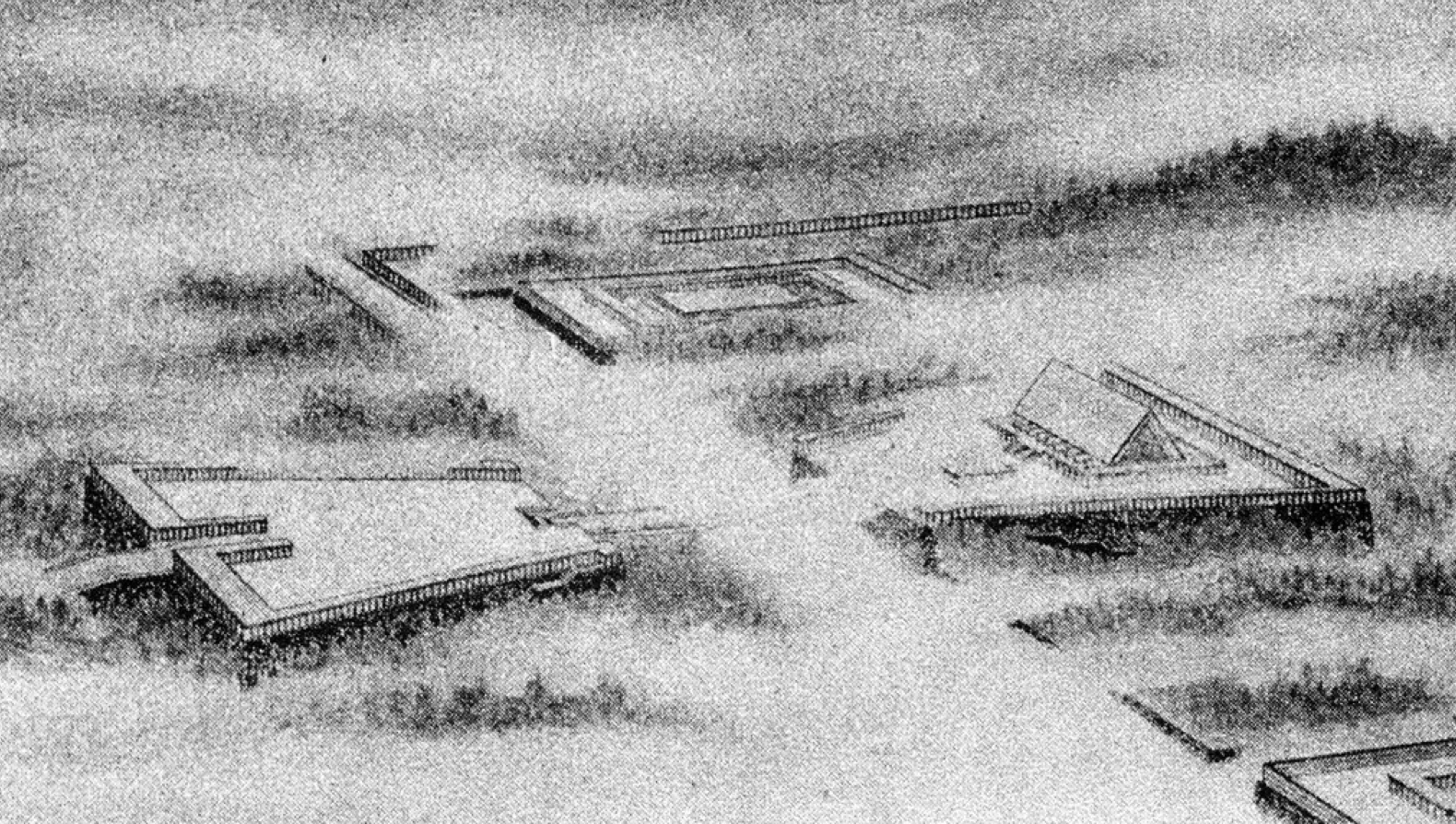
Tange, Greater East Asia Co-Prosperity Sphere Memorial Hall Competition design, 1942
The ideal of Ise to proclaim Japan’s position as a world power poised to dominate Asia during WWII (assuming Japan won the war)
Making Ise extremely public vs small and intimate
To legitimize the imperial institution
Close tie between Japan’s imperial ambition during the war and Ise
“The ghost of Japanese imperialism”
Lot’s of open space
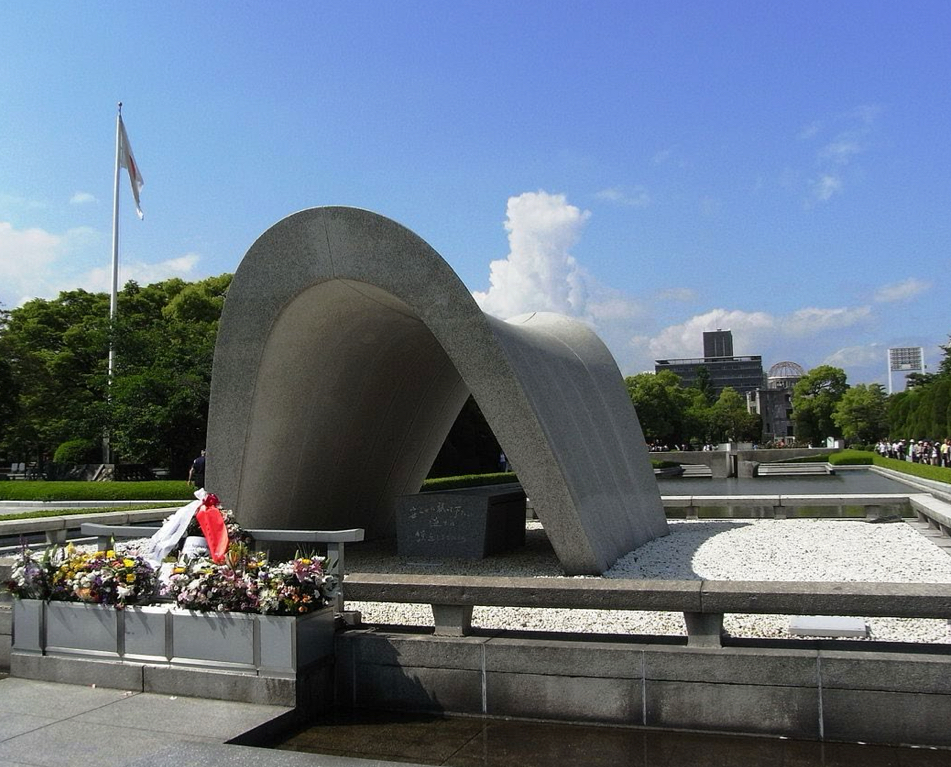
Tange Kenzo, Hiroshima Peace Memorial Park, 1955
Lot’s of open space covered in white pebbles, similar to Ise and even a Zen garden
The shape of the structure echoes an ancient grain/storehouse style
Based on a haniwa
Monumental in size and also in its Japaneseness
Very simple, straightforward, clear, very Japanese
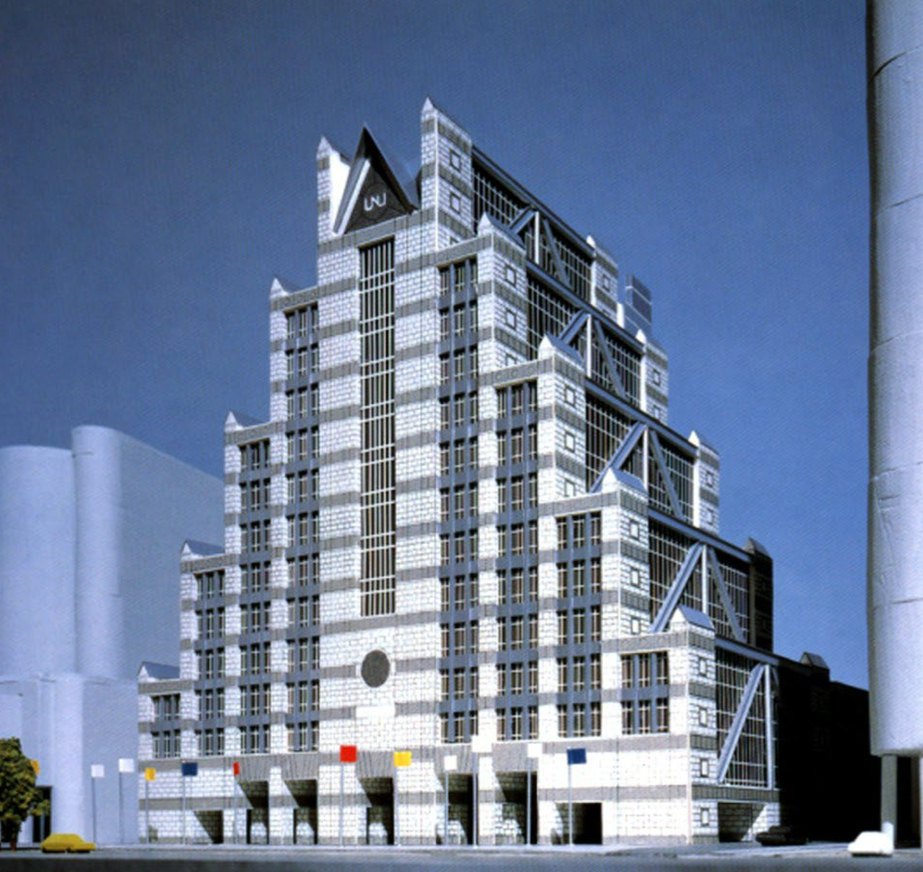
Tange United Nations University Headquarters and Trust Building, Tokyo, 1985-95
Very moden: steel frame construction, plate glass, electricity, elevator, reinforced concrete, tall
Also very Japanese/tied to Ise: gabled roof/slanted roof/strong diagonals, the industrial grid lines in the windows echoes the fence of Ise, very symmetrical and proportional with clean lines